K. BHANU TEJA 17011AA006
UNDER THE GUIDANCE OF Ar. M. Bharath
SCHOOL OF PLANNING ANDARCHITECTURE, JAWAHARLAL NEHRUARCHITECTURE AND FINEARTS UNIVERSITY, HYDERABAD.
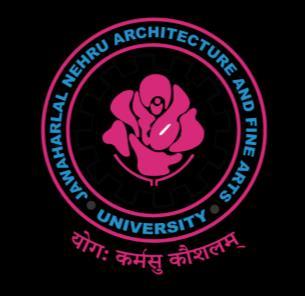
Design Thesis 2022 SMART VILLAGE
SCHOOL OF PLANNING ANDARCHITECTURE (Autonomous Institution)
JAWAHARLAL NEHRUARCHITECTURE AND FINEARTS UNIVERSITY

(Part of erstwhile unified Jawaharlal Nehru Technological University, Hyderabad.)
DEPARTMENTOFARCHITECTURE
This is to certify that the dissertation/project entitled SMART VILLAGE submitted by Mr. K. BHANU TEJA bearing Hall Ticket No 17011AA006 on this day of March, 2022 in partial fulfillment of the requirements for the award of the Degree of BACHELOR OF ARCHITECTURE of this University is a bonafide work to the best of my/our knowledge and may be placed before the Examination Board for their consideration.
Supervisor/s ThesisCoordinator
Head, ExternalExaminer DepartmentofArchitecture
……………………………
PRINCIPAL i
..….……………..
DECLARATION
I hereby declare that the thesis entitled SMARTVILLAGE submitted for the award of the degree of Bachelor ofArchitecture is original research work done by me and no part of this thesis has been submitted to any other university for any other degree or diploma.
Name: K. BHANU TEJA Signature: ____________
Place: HYDERABAD Date:
ii
ACKNOWLEDGEMENT
With deep regards, I sincerely thank the Principal, SPAJNA & FAU Prof. Dr. S. Kumar and Head of The Department Architecture SPA JNA & FAU, Prof. Ch. Srinivas.
I am thankful to Asst. Prof. Ar. Kali Krishna, Thesis coordinator, SPA JNAFAU for his valuable suggestions during this course
My sincere acknowledgement to thesis supervisor Ar. M. Bharath, for his valuable inputs. His advice, guidance and encouragement enabled me to evolve and complete my thesis.
I wish to express my gratitude to my family and friends who had supported and helped me in completing my thesis
Name: K. BHANU TEJA
Signature:
iii
ABSTRACT
Villages are the biggest strength to India.. They are the one with which the whole world recognizes India. They are the ones that doesn't depend on any cities, but every city depend on villages for their survival.
India lives in its village. Villages are the food basket of the nation. The concept of “Smart Village” will address the multiple challenges faced for sustainable development in rural India such as poverty, unemployment, migration, and inadequate infrastructure
In this project, we describe the ecosystem for a village and then map out an integrated design procedure for building a smart village. A ‘‘Smart Village” will encompass a Sustainable construction which seeks to reduce negative impacts on the environment, and the health and comfort of building occupants, thereby improving building performance The basic objectives of sustainability are to reduce consumption of non-renewable resources, minimize waste, and create healthy, productive environments.
The Socio-economic dualism in Indian economy is tackled by the Government by taking responsibility for uplifting the rural and the economically poorer sections. The concept of smart village rests on the utilization of state of the art working facilities and services for supporting the advancement of rural areas and businesses.
The basic concept of smart village is to collect community efforts and strength of people from various streams and integrate it with information technology to provide benefits to the rural community.
This is the backdrop of our interest for this project “Smart village” which goes in line with the vision of Mahatma Gandhi – “The best, quickest and most efficient way is to build up from the bottom. Every village has to become a self-sufficient community. This does not require brave resolutions. It requires brave, corporate, smart work.”
According to Mahatma Gandhi’s philosophy and thoughts smart village project provides, “Global means to the local needs.”
iv
TABLE OF CONTENTS
01. SYNOPSIS ……………………………………....08 - 12 1.1 Introduction 1.2Aim 1.3 Objectives 1.4 Scope 1.5 Limitations 1.6 Methodology
02. LITERATURE STUDY………………………... 13 - 58 2.1 Classification of human settlements 2.2 What is a village? 2.3 Villages of India 2.4 Main Characteristics of Village Community in India 2.5 Villages of India – strengths and weaknesses 2.6 Gandhian concept of village development 2.7 Provision of Urban Amenities in Rural Areas (PURA) 2.8 Smart village 2.9 The current state of Indian villages 2.10 Need for smart villages in India 2.11 Concept of smart villages 2.12 Benefits of smart villages 2.13 What turns a village into a smart village? v
SMART VILLAGE 17011AA006
03.
SMART VILLAGE 17011AA006
dimensions,
Housing 2.19 Group housing 2.20 Types
group
2.21 Street patterns 2.22Affordable housing 2.23 Green affordable
2.24 Safety perceptions 2.25 Energy efficient
2.14 Towards development of smart village 2.15 Methodologies for the design of a smart village 2.16 Smart Village Ecosystem 2.17 The
aspects, and indicators of Smart Village 2.18
of
housing
housing
design
DATA
89 3.1 Building rules and regulations 3.2 Standard requirements of a housing society 3.3 Building norms and standards 3.4 Standards for different space components 3.5 Survey of a village
DESKTOPSTUDIES ………………………….90
116 4.1Auroville, India 4.2 Sunflower village 4.3 Odanthurai, Tamil Nadu, India 4.4Agrihood, Santa Clara, Canada vi
COLLECTION …………………………. 59 -
04.
-

SMART VILLAGE 17011AA006
SITE
- 129 5.1 Location 5.2About Bhuvanagiri 5.3 Demographics 5.4 Land use zone classifications 5.5 Proposed land use
5.6 Site details 5.7About the site 5.8 Site surrounding context 5.9 Climatic data 5.10 Topography 5.11 Connectivity 5.12 Proximities 5.13 Site plan 5.14 Site measurements 5.15Aerial
the
vii
05.
ANALYSIS ……………………………...117
zoning of Bhuvanagiri – 2031
view of
proposed site 06. BIBILIOGRAPHY…………………………………130
01. SYNOPSIS
08 SMART VILLAGE 17011AA006
1.1 Introduction
A small community or group of houses in a rural area larger than a hamlet and usually smaller than a town is known as village and villagers equipped with all the modern services/ technologies without destroying the nature is known as Smart Village.
Smart village is a concept adopted by national state and local government of India as an initiative focused on holistic rural development derived from Mahatma Gandhi’s vision of ideal village and village self-rule / independent.
We define a Smart Village as a bundle of services which are delivered to its residents and businesses in an “effective and efficient manner” Dozens of services including housing, farming, electricity, heath care, water, retail, manufacturing and logistics are needed in building a smart village. Computing, communication and information technologies also play a major role in design, delivery and monitoring of the services.
This project report deals with study and development of village as a smart village with green affordable housing for farmers We can make smart village by taking smart decisions using technologies and services.
The vision of smart village is that the modern energy access can act as catalyst for rural development in education, health, sanitation, security, productive enterprise, environment that in turns support further improvement in access to energy
The smart village concept can do wonders if applied carefully also integrating inclusive growth along with environmental planning.
A ‘‘Smart Village” will encompass a Sustainable construction which seeks to reduce negative impacts on the environment, and the health and comfort of building occupants, thereby improving building performance
The basic objectives of sustainability are to reduce consumption of non-renewable resources, minimize waste, and create healthy, productive environments.
There is an urgent need for designing and developing “Smart Village”, which are independent in providing the services and employment and yet well connected to the rest of the world.
Based on various programs undertaken taken by Central and State governments along with further technological Initiatives, the Smart Village can achieve smart infrastructure, smart service delivery, and smart technology. A ‘‘Smart Village” will encompass a sustainable and inclusive development of all sections of the village community, so as they enjoy a high standard of living.
09 SMART VILLAGE 17011AA006
1.2Aim
• The aim is to design the village by incorporating green affordable housing, agricultural development and inclusive of required services to create better infrastructure and a healthy society, for rural people to experience an improved quality of life.
1.3 Objectives
• India lives in its village. Villages are the food basket of the nation. The concept of “Smart Village” will address the multiple challenges faced for sustainable development in rural India such as poverty, unemployment, poor and inadequate infrastructure.
• The objective of the project is to plan a layout for village, design affordable green housing, build infrastructure and incorporate services such as educational institutions, health facilities, clean drinking water, banks, resource use efficiency, sanitation facility, waste management, and renewable energy source with cost effective and durable methods.
• To prove that main occupation of India (agricultural sector) can generate more income if advanced services and techniques are used, which will in turn increase the economy and decrease the poverty levels of a village. Hence creating a circular self sustainable economy which will further result in another rural development
• To build a village in sustainable ways for the future generation, by not repeating the same mistakes we have done in the previous generation, in order to save the nature.
• The building construction has to be built with locally available materials to reduce the carbon footprint area of the materials
• The planning of a smart village should be done considering the factors which contaminate a society such as air pollution, water pollution, plastic disposal and green house gases. The smart villages must be preferably located on the outskirts of the cities for technical provision, mobility and logistics, and also act as a supplier of raw materials for cities. But it should be located far enough to avoid the city’s pollution and industrial wastage
• Smart village will also consider the climate change and switch to electric vehicles for better environment
• The construction area will constitute only minor portion of the site, while major portion of the site will be allocated to green areas, landscaping, parking lots and recreation activity centers to preserve the green cover.
10 SMART VILLAGE 17011AA006
1.4 Scope
• The concept of “Smart Village” will address the multiple challenges faced for sustainable development of rural India A “Smart Village” will provide long-term social, economic, and environmental welfare activity for village community, which will enable and empower enhanced participation in local governance processes, promote entrepreneurship and build more resilient communities
• A smart village can develop affordable housing for the inhabitants with locally available materials and labour which can in turn decrease carbon foot print of the materials. A smart village can also contribute to global environment. The system can reduce reliance on fossil fuels & contribute to reduction of greenhouse gases such as carbon dioxide. Energy consumption optimization can save 25-30% average energy
• A smart village can develop agriculture sector by introducing advanced technologies to yield more production of crops. It also has a scope of developing “Farmer e-learning” facility which will be able to answer their quarries online.
• A smart village has a scope of producing local energy and therefore locally consume it In villages if the mountains or hilly areas are present then use of solar energy & wind energy is produced in that village itself & used for development of village.
• A smart village also has a scope of creating jobs and boosting the village’s economy Generally, village people migrate from village to city for purpose of job If village becomes smart so all the job requirements are fulfilled, people will not migrate from one place to another.
• All the techniques and technologies needed to build a smart village are available now. We recognize that the need of the hour is strategy, integrated planning and above all monitoring and execution of the activities using appropriate governance models. Our integrated design is a way forward to deal with the demographic deficit and also achieve the goals of inclusive growth.
• Smart village prototype is having a high replication potential in other countries of developing world, which can be also be built surrounding to the bigger cities of India.
11 SMART VILLAGE 17011AA006
1.5 Limitations
• The emphasis on architecture’s contribution towards this smart village is dedicated to green affordable housing.
• As it is a vast topic, the project is only limited to designing and planning of the smart village, but does not incorporate any structural details and working drawings of the project.
• The proposed project does not provide information on statistical economic growthat the end, but provides a general theoretic impact of its benefits.
1.6 Methodology

12 SMART VILLAGE 17011AA006
02. LITERATURE STUDY
13 SMART VILLAGE 17011AA006
2.1
Classifications of human settlements

Hamlet
A hamlet has a tiny population of less than 100 and very few services, with only a few buildings.
Village
A village is a human settlement or community that is larger than a hamlet but smaller than a town. It is in a rural area. A village generally does not have many services, most likely a small clinic or temple/church or only a small shop or post office. The average population can range from 100 to 1000.
Town
A town does not have a large population, like a city. It has low buildings, narrow streets, small shops and markets Atown has a population of 1,000 to 100,000
City
Acity is a large and permanent human settlement. It has tall buildings, big avenue, big shops and lots of traffic It would have abundant services The population of a city is between 100,000 to 1,000,000 (one million).
Metropolis
A large city which is a significant economic, political, and cultural center for a country and its suburbs consisting of multiple cities and towns. Ametropolis has many inhabitant. The population is usually 1,000,000 (one million) to 1,000,000 (three million).
14 SMART VILLAGE 17011AA006
2.2 What is a village?
A village is a clustered human settlement or community, with a population typically ranging from a few hundred to a few thousand Though villages are often located in rural areas, the term urban village is also applied to certain urban neighborhoods Villages are normally permanent, with fixed dwellings Further, the dwellings of a village are fairly close to one another, not scattered broadly over the landscape, as a dispersed settlement Historically homes were situated together for sociability and defence, and land surrounding the living quarters was farmed. Social structure of a village is traditional. Most of the villages have their own temple, mosque, or church, depending on the local religious following.
In the past, villages were a usual form of community for societies that practice subsistence agriculture, and also for some non-agricultural societies. A rural area or village in India is a geographic area that is located outside cities and towns, where most of the land is used for agriculture. In these villages, agriculture is the chief source of livelihood along with fishing, cottage industries, pottery, etc
A village is also said to be a pollution free, peaceful area located far from city’s environment. Avillage is a small community in a rural area. Atown is a populated area with fixed boundaries and a local government A city is a large or important town.

15 SMART VILLAGE 17011AA006
2.3 Villages of India
Demographics
India is a land of villages There are more than 6,40,000 villages in India According to 2015 census, 72.2% (833 million people) of population lives in villages They depend mostly on agriculture and small scale industries such as handloom, dairy farm, poultry farm and etc.
India lives in its villages. Due to diverse geographical terrain the size of the villages is small, in plain areas the villages tend to be bigger The size of these villages varies considerably. Out of a total of 5.94 lakh inhabited villages in the country, the largest number of villages (1 45 lakh)are in the population size group of 500-999 persons, followed by the groups 100-1999 (1.30 lakh) and 200-499 (1.28 lakh). There are 3,961 villages, which have a population of 10,000 persons or more.
Economic sector
The villages of India have good environment with less pollution and more greenery They don’t spoil the fertility of land but instead preserve it Our basic need is food and it comes from villages. According to 2021, agriculture, fishing and forestry contribute to 20.19% of GDP in India.
Villages are the biggest strength and backbone to India, supporting the nation from past to future.

16 SMART VILLAGE 17011AA006
2.4 Main Characteristics of Village Community in India
Some of the important Characteristics features of Village Community in India are as follows:
1. Bases of social organization:
In India there are more than half a million villages. Eighty per cent of the Indian population lives in these villages Hence, in every respect the future of India is very much linked with the development of villages.
2. Group of people:
Village community signifies a group of people in which the people do not take part in a particular interest. On the other hand, they share the basic conditions of a common life.
3. Definite locality: Locality is the physical basis of village community A group of people forms village community only when it begins to reside in a definite locality.
4. Small size:
Village communities are small in size The census in India designates a place with 5000 inhabitants as a village community. 80% of the Indian villages have less than 1000 population each
5. Importance of neighborhood:
Neighbourhood relationship is another important feature of village life. The village community is concerned, each one loves his neighbour as he loves himself. He, in fact, considers his neighbour more important than the relatives living far away from him. He always sides with his neighbour in the face of any difficult situation.
6. Community sentiment:
Community sentiment is the very essence of village community. The ruralites exhibit a strong sense of belongingness and we-feeling Often “my own village” is the natural expression of such community sentiment. Furthermore, the members have a sense of dependence on the community for both physical and psychological satisfaction.
7. Marriage:
The villagers, for the most part, practice endogamy There is either no or very little freedom on the part of both boys and girls in matters of mate selection.
17 SMART VILLAGE 17011AA006
8.
Joint family system:
The joint family system still forms the basic structural unit in the village community All the members live together under the same roof, take food cooked in the common hearth, hold property together, participate in common worship and are related to each other as some particular type of kindred It is found that the number of joint families in villages is much more than that in towns and cities.
9. Culture:
So far as village community is concerned, culture is more static than in towns Greater importance is attached to religion and rituals. The ruralites are found to be more fatalistic than the urbanites.
10.
Agricultural economy:
Agriculture is the biggest occupation in rural India. It is essentially a way of life for the ruralites as their whole mode of social life, daily routine, habits and attitudes revolve round agriculture A small section of the rural population depend upon non-agricultural occupations such as carpentry, pottery, basket making etc for their livelihood but these occupations are also indirectly related to the major occupation that is agriculture.
11.
Stability and continuity:
The village communities in India are relatively more stable The reason is possibly attributed to the relative static character of ruralism as a way of life – the norms of behaviour, customs of family relations, traditions of community life etc In fine, these are some of the most important characteristics of a village community. Life in the village is more natural and orderly.
12.
Homogeneity:
Homogeneity of population is another important feature of village communities. The members of a village exhibit similarities in their dress, speech, beliefs, values, attitudes and behaviour
13.
Simple life:
It is interesting to observe that even in the materialistic age of today, the generally accepted ideal in the village is one of simple living and high thinking The villagers are a simple and plain people. Their life is tranquil and peaceful.
14. Faith in religion:
Religion plays a paramount role in the life of the village Religious influence is discernible in every important activity of village life like sowing, harvesting of crops, birth, marriage, illness, death etc. On all such occasions, the ruralites conduct religious ceremonies in the form of ‘Puja’, ‘Mela’ or ‘kirtan’. In this way, faith in religion is very strong in villages.
18 SMART VILLAGE 17011AA006
15. Panchayat:
The functioning of the village as a political and social entity brought together members from different castes. The traditional village Panchayat in the shape of village council performed a variety of tasks, including the maintenance of law and order, settling of disputes, celebration of festivals and construction of roads, bridges and tanks. On the other hand, matters relating to the caste rules, property and family disputes and other activities of serious nature were dealt with by the caste Panchayat.
17. Informal social control:

In village communities, social control is informal and direct The primary groups like the family, neighbourhood act as powerful agencies of social control in villages The traditional village Panchayat and the caste Panchayat also exercise much control on the deviant members of the community.
18.
Mobility:
Territorial, occupational and social mobility of the rural population is limited The reason is attributed to the lack of satisfactory spread of education in the rural areas
19. Status of women:
Generally the women in villages are not much educated and their social status is lower than that of their counterparts in the towns. Factors like prevalence of child marriage, joint family system, traditional ideals, old values and lack of education among females are responsible for the low status of women.
20. Standard of living:
On account of gross poverty and lack of adequate employment opportunities, the standard of living of the ruralites is very low. Hence most of them do not have home conveniences and recreational facilities
22. Preservers of ancient culture:
From the sociological point of view, the villages are important because they preserve the ancient culture of the Indian society The villagers in India still have faith in the lofty ideals of the theory of Purushartha and the doctrine of Karma and lead a simple and natural life marked by sacrifice, theistic tendency etc.
19 SMART VILLAGE 17011AA006
2.5 Villages of India – strengths and weaknesses

According to me, Indian villages are our strength as well as weakness.
First, let’s see how Indian villages become a strength for us:
• The cultural heritages, traditions, family values and festivities which binds our nation have originated from villages.
• Village people are mostly hard working, united and active.
• Our basic need is food and it comes from villages
• Our economy is engaged in primary sector compared to other two sectors like secondary & tertiary.
• Villages preserve the soil fertility which in turn increases employment in the primary sector
• Villages have good environment with more greenery and less pollution.
• There is abundant source of raw material and food production
• For export of agriculture products worldwide, we depend mostly on agriculture
• People become self-reliant.
• Life style of villagers is so simple, so their needs are limited There is less consumption of fuel, electricity and transport.
• Indian villages promote small scale industries like handloom industry, dairy farm, poultry farm and matchbox industry, etc.
Now how Indian villages are a weakness :
• The literacy levels of villages are very low, due to lack of education.
• Rural development is a major challenge facing our country because of the economy generated.
• Poverty levels as agriculture may not yield sufficient income
• Lack of awareness about government schemes, so no further development.
• No proper infrastructure
• The beliefs of villagers are too old for the present generation culture.
• No proper sanitation because of low hygiene standards
20 SMART VILLAGE 17011AA006
2.6 Gandhian concept of village development
The word Swaraj is a sacred word, a Vedic word, meaning self-rule and selfrestraint, and not freedom from all restraint, which ‘independence’often means In other words, Swaraj is to be obtained by empowering the masses to a sense of their capacity to regulate and control authority
The Gandhian vision of an ideal village or village Swaraj is that it is a complete republic, as self-sufficient community, independent of its neighbours for its own wants and yet interdependent for many others in which dependence is necessary
According to Gandhiji, the making of an ideal village is very simple. He says: “An ideal Indian village will be so constructed as to lend itself to perfect sanitation. It will have cottages with sufficient light and ventilation built of a material obtainable within a radius of five miles of it. The cottages will have courtyards enabling householders to plant vegetables for domestic use and to house their cattle The village lanes and streets will be free of all avoidable dust It will have wells according to its needs and accessible to all. It will have houses of worship for all, also a common meeting place, a village common for grazing its cattle, a co-operative dairy, primary and secondary schools in which industrial education will be the central fact, and it will have Panchayats for settling disputes It will produce its own grains, vegetables and fruit, and its own Khadi. This is roughly my idea of a model village I am convinced that the villagers can, under intelligent guidance, double the village income as distinguished from individual income There are in our villages’ inexhaustible resources not for commercial purposes in every case but certainly for local purposes in almost every case. The greatest tragedy is the hopeless unwillingness of the villagers to better their lot. My ideal village will contain intelligent human beings. They will not live in dirt and darkness as animals. Men and women will be free and able to hold their own against anyone in the world.”
- MAHATMA GANDHI

Father Of The Nation
Mahatma Gandhi believed in a self-sufficient village economy.
21 SMART VILLAGE 17011AA006
2.7
Provision of Urban Amenities in Rural Areas (PURA)
According to the PURA (provision of urban amenities to rural area) project which is visionary of late Mr A P J Abdul kalam (ex-president of India), a concept of smart villages was born.
Provision of Urban Amenities in Rural Areas (PURA) is a Central Sector scheme re-launched by Ministry of Rural Development (MoRD), Government of India during remaining period of the XI Plan with support from Department of Economic Affairs and the technical assistance of Asian Development Bank MoRD intends to implement the PURAscheme under a Public Private Partnership (PPP) framework between Gram Panchayat(s) and private sector partners. The scheme envisages twinning of rural infrastructure development with economic regeneration activities and is the first attempt at delivering a basket of infrastructure and amenities through PPP in the rural areas. It is an effort to provide a different framework for the implementation of rural infrastructure development schemes and harness private sector efficiencies in the management of assets and delivery of services. This would perhaps be the first such attempt at PPP in integrated rural infrastructure development and management in the world
Mission Statement
Holistic and accelerated development of compact areas around a potential growth centre in a Gram Panchayat (or a group of Gram Panchayats) through Public Private Partnership (PPP) framework for providing livelihood opportunities and urban amenities to improve the quality of life in rural areas
Main functions
Formulation of policy guidelines, release of funds under PURA scheme, selection of private developers and its monitoring and evaluation.
The urban amenities proposed under PURAscheme
An illustrative list of amenities and economic activities proposed to be provided under PURA are as follows:-
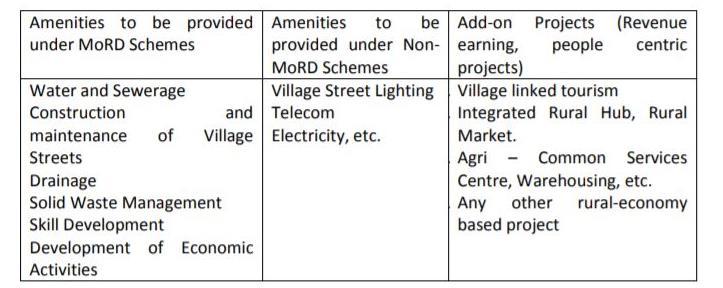
22 SMART VILLAGE 17011AA006
Aim and objectives of PURAscheme
The project had a simple aim of providing basic amenities like infrastructure, education, awareness, technology and many more. The objective of the mission is to improve the economic, social and infrastructural development in the rural areas
The PURAScheme (provision of Urban Amenities in Rural Areas) envisages rapid growth of rural India -- given enhanced connectivity and infrastructure, the rural population would be empowered and enabled to create opportunities and livelihoods for themselves on a sustainable and growing basis.
The primary objectives of the scheme are the provision of livelihood opportunities and urban amenities in rural areas to bridge the rural – urban divide, thereby reducing migration from rural to urban areas
This can be achieved in three ways:
• improving the life of people of the rural clusters
• bridging the rural-urban divide
• reducing distress migration from rural to urban areas in order to provide these amenities technologies like GIS can be very helpful where mapping the existing scenario, land use and data from other types of surveys can be put into the software to analyze the situation for implementation of the project (which is provision of basic amenities).
GIS can act as an important factor in analyzing the situation which can ultimately help in decision making, for instance; spending the local body funds in providing priority basic amenity according to the needs of the people like water may be more crucial than providing wider roads for future predicted increased traffic.
Features of PURA scheme
The objectives of PURA are proposed to be achieved under the framework of Public Private Partnership between Gram Panchayats and private sector partner with active State Government support Core funding shall be sourced from the Central Sector scheme of PURA and complemented by additional support through convergence of different Central Government schemes The private sector shall also bring on board its share of investment besides operational expertise. The scheme would be implemented and managed by the private sector on considerations of economic viability but designed in a manner whereby it is fully aligned with the overall objective of rural development.
Simultaneous delivery of key infrastructure in villages leading to optimal use of resources Combining livelihoods creation with infrastructure development
The funding source for PURAscheme
Funding for projects under PURA scheme may come from four sources: MoRD schemes, non-MoRD schemes, private financing and Capital Grant under PURA
23 SMART VILLAGE 17011AA006
2.8 Smart village
A small community or group of houses in a rural area larger than a hamlet and usually smaller than a town is known as village and villagers equipped with all the modern technologies without destroying the nature is known as smart village.
Smart village is a concept adopted by national state and local government of India as an initiative focused on holistic rural development derived from Mahatma Gandhi’s vision of ideal village and village self-rule / independent
We define a Smart Village as a bundle of services which are delivered to its residents and businesses in an “effective and efficient manner” Dozens of services including housing, farming, electricity, heath care, water, retail, manufacturing and logistics are needed in building a smart village Computing, communication and information technologies also play a major role in design, delivery and monitoring of the services
This project report deals with study and development of village as a smart village. We can make smart village by taking smart decisions using technologies and services. The vision of smart village is that the modern energy access can act as catalyst for rural development in education, health, sanitation, security, productive enterprise, environment that in turns support further improvement in access to energy The smart village concept can do wonders if applied carefully also integrating inclusive growth along with environmental planning.
The concept of smart village rests on the utilization of state of the art working facilities and services for supporting the advancement of technology based business.
The basic concept of smart village is to collect community efforts and strength of people from various streams and integrate it with information technology to provide benefits to the rural community. According to Mahatma Gandhi’s philosophy and thoughts smart village project provides, “Global means to the local needs.”

24 SMART VILLAGE 17011AA006
2.9 The current state of Indian villages:
Of India’s 610 districts, the National Rural Employment Guarantee Act has a list of 200 backward districts Similarly, out of India’s 600,000 villages, around 125,000 are truly backward. There is no proper water supply, no sanitation, no electricity and not good connectivity with urban areas It means villagers are not getting their basic needs in our country after 70 years of freedom when technologies are very smart.
On the other hand, the villagers themselves are a powerhouse of a large pool of manpower. But without sources, they cannot do anything. About 600 million people of India lives in villages and at least half of them are below 25 years of age They will become the future of India, without education and health
It is very necessary to make the country developed that:
• The new generation of workers should be healthy and educated
• The government move to build social infrastructure (housing, healthcare, schools, colleges, and universities)
• In villages, there should be a proper water supply, electricity supply with good sanitation
• Villages should be connected to urban areas with a good road network
There are 78 regions in the country, as per the NSS (National Sample Survey) classification. Based on these regions, the World Bank (2004) identifies 18 regions where human development is low. Currently, there is lot of public spending to improve the infrastructure, water and sanitation in these areas.
The Socio- economic dualism in Indian economy is tackled by the Government by taking responsibility for uplifting the rural and the economically poorer sections. The Government does this by giving subsidies, loan waivers, and quota systems in educational institutions, jobs and offering several other schemes based on caste and profession All these efforts are disparate, fragmented and piecemeal efforts and not much improvement has been achieved in most of the villages.
By not providing attention to this aspect, the planners are creating huge opportunity for several devastating risks of either huge epidemics or diseases such as HIV, TB, and hepatitis sweeping across the country and also for raise of unrests by jobless. There is no integrated approach for a village design so far and various services are provided in an ad hoc manner. Most of them are left unfinished or not maintained properly.
Schemes such as NREGAS provide employment for some rural folks but these have become breeding grounds for huge leakages and corruption Though IT services are provided by leading service providers such as TCS, NIC, HP and others, these automate the existing manual accounting processes
25 SMART VILLAGE 17011AA006
There are a few initiatives like e-panchayats and e-kiosks, designed to provide information and for payment of bills While these efforts are really laudable and may be meeting the identified goals but they are still not strategically designed to contribute to the growth of the village in a wholesome fashion Thus, the design of a village with all the essential utility services such as electricity, heath care, water and employment guarantee through farming and small scale industries is an important issue. Therefore there is an impending need to reconsider design of a village and hence Smart Villages.
In recent times, there is an immense interest in the development of Smart Cities. But as we perceive, in the Indian context, villages are the heart of the nation Hence, for the development to percolate to the grass root level, focus must be devoted to the progress of villages In spite of a large scale migration of people from rural to urban areas, which is increasing the burden and posing a huge threat to the cities, still there are some villages which are thickly populated The main aim is to smarten the villages using advanced wireless, IT and other latest technologies and also to encourage entrepreneurial attitude among its residents to achieve self sustainability.
This is the backdrop of our interest for this paper which goes in line with the vision of Mahatma Gandhi – “The best, quickest and most efficient way is to build up from the bottom. Every village has to become a self-sufficient republic. This does not require brave resolutions. It requires brave, corporate, smart work.
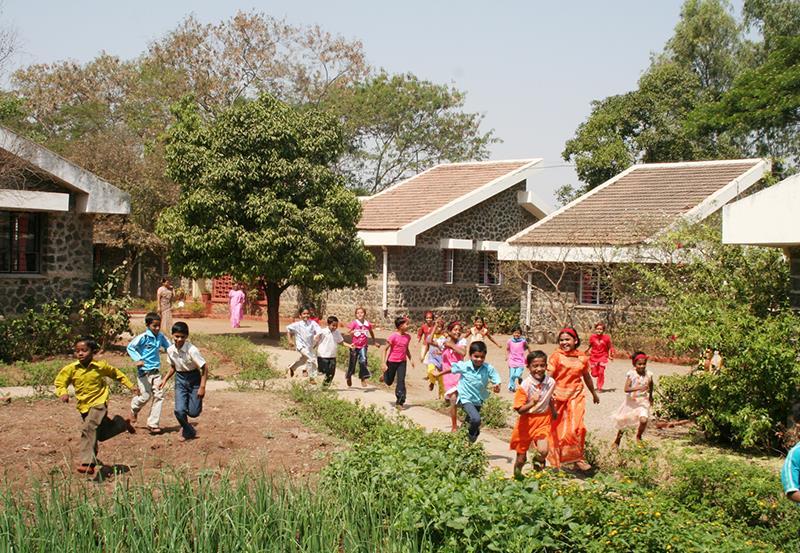
26 SMART VILLAGE 17011AA006
2.10 Need for smart villages in India
In the Indian context, villages are heart of the nation. According to the 2011 census of India, the rural area population is 68 84% , where as urban area population of 31.16% only. In India there are 6,40,867 villages, out of them 1,12,510 villages are backward, so there is a need for designing and building the village as a “smart village” as many villages are under-developed.
With modern nation and urbanization people migrate from one place to another place for different facilities such as educational employment and affinity of people towards the locality or city. Villages are main criteria for development of nation so develop the village in such a way that which is self-dependent in providing the service employment and well connected to the rest of world i e smart village The smart village corrects the social oversight by providing accommodation for sustainable family relationship without disturbing the lifestyle of different generation.
About 800 million people in India live in villages and at least half of them are below 25 years of age There is a lot of youth in this nation which can develop the country’s growth and economy if guided properly. The Government takes responsibility for uplifting rural and poorer regions Based on various programs undertaken taken by Central and state governments, there is lot of public spending to improve the infrastructure, water quality and sanitation in these areas. But these efforts are disparate, fragmented and not much improvement is achieved in most of the villages.
At present, one of the major challenges in India is growing population and rapid urbanization Imbalance growth between rural and urban landscapes leads to the challenge of rapid growth in already crowed Indian urban masses. Due to uncontrolled urbanization in India, environmental degradation has been occurring very rapidly and causing many problems like climate change, emissions of greenhouse gases, fossil fuels, land insecurity, worsening water quality, excessive air pollution, noise pollution, health hazards and the problems of waste disposal. One of the main consequences of uncontrolled urbanization is lack of livelihoods, good standard of living and amenities in the villages of India. Lack of proper education facilities is leading the way to move to cities for higher education Some of the rural people are migrating to cities for economic pursuits.
Smart village concept may play crucial role in maintaining the balance between the development of rural and urban areas and help to reduce migration of rural population in urban areas. There is a need for designing and building Smart Villages which are independent in providing the services and employment and yet well connected to the rest of the world Hence, for the overall development of the country the focused must be given to the grass root level, and that means the focus areas should be the Indian villages
27 SMART VILLAGE 17011AA006
2.11 Concept of smart villages
The basic concept of smart village is to collect community efforts and strength of people from various streams and integrate it with information technology to provide benefits to the rural community. According to Mahatma Gandhi’s philosophy and thoughts smart village project provides, “Global means to the local needs.”
The concept of the smart village is as defined below: S Social, Skilled and Simple

The idea of a smart village in the present day context seems more plausible as there is a limit of growth of cities which is leading to the creation of urban jungles, where the population ratio per km of land is way above the desired norms
Services required for smart village are :
1. Food security.
2. Democratic engagement – (i) Good governance (ii) Social development
3. Health welfare - (i) Environmental development (ii) Personal development
4. Education - Basic knowledge for awareness
5. Local business - economic development.
“If the facilities available in the cities are not made available to the rural population, the Governments will not have done their duties” - Dr.A.P.J. Abdul Kalam, Former President of India.
28 SMART VILLAGE 17011AA006
Aware,
R Responsive and Ready
Techno-Savvy
M Moral, Methodical and Modern A
Adaptive and Adjusting
T
and Transparent
2.12 Benefits of smart villages
We know that India is a developing nation, with the help of smart village we can make India as a smart nation. Now-a-days our government also gives strong focus on smart village. Government implements so many schemes on smart village. This concept will involve
• smart governance,
• smart buildings,
• smart mobility,
• smart education,
• smart healthcare,
• smart infrastructure,
• smart environment,
• smart business,
• smart energy and
• smart sanitization.
• smart agriculture and irrigation
All these smart factors refer to new innovative ways which will facilitate life and satisfy the needs of people, community and lead to an improved quality of life, without having any negative impacts on nature. This development will further boost country’s economy
Benefit of the smart village efforts are foreseen to be tremendous, it will create agricultural growth, economy, institutions, government jobs and also women empowerment.
A “Smart Village” will provide long-term social, economic, and environmental welfare activity for village community, which will enable and empower enhanced participation in local governance processes, promote entrepreneurship and build more resilient communities
By implementing smart energy such as solar energy and wind energy, we can achieve sustainable electricity supplies.
Smart Villages will not only reduce the rapid urbanization and migration but also irrigate the population flow from urban to rural area. The working load may distributed from city towards village and economic condition will be good.
A specially designed suitable framework for rural areas on the grounds of Architecture, Science, Technology, Engineering, Regulations and Management will play important role to build next generation smart village Thus, Smart village concept will have potential to uplift the grassroot level of the country, hence adding feather in the overall development of India
29 SMART VILLAGE 17011AA006
Introducing services such as housing, education, healthcare, transport, renewable energy, digitization, advanced farming will contribute to India’s economy. Having such institutes and facilities will create employment opportunities for villagers and these job opportunities will therefore promote women empowerment. This will create a self sustaining economy for the village
Other Benefits
• Locally produced and locally consumed energy: In villages if the mountains, hilly area are present then use of solar energy & wind energy then energy is produce in that village itself & use for development of village
• Creation of job: Generally village people migrate from village to city for purpose of job. If village becomes smart so all the job requirements are fulfils & people not migrate from one place to another

• Contribution to global environment: The system can reduce reliance on fossil fuels &contribute to reduction of greenhouse gases such as carbon dioxide. Energy consumption resulting in optimization 25-30% average energy saving.
• Farmer e-learning etc. facility that will be able to ask there quarries online.
• New technologies in education, e-learning, desktop publishing, horoscope generation of interested person of the village Transportation of village into comfortable & safe space that enhance quality
30 SMART VILLAGE 17011AA006
2.13 What turns a village into a smart village?
Smart villages is about rural people who take the initiative to find practical solutions both to the downsides under the exciting new opportunities arising locally Smart means using every tool available, digital technology is just one of them.

➢ Implementation of the following facilities will transform a village into a smart village
An ideal village should have many qualities, such as:
• An ideal Indian village will be constructed to lend itself to perfect sanitation and drinking water
• It will have houses with sufficient light and ventilation built of local materials.
• In which nobody is illiterate, Education will be compulsory up to the final basic course.
• Safety and Security should be the key features
• In which nobody is without work, and which is free from quarrels and thefts.
• Where the roads are clean, there is a fixed place for evacuation
• It will have houses of worship for all; also a common meeting place, a village common for grazing its cattle, a cooperative dairy, primary and secondary schools in which industrial education will be the central fact, and it will have panchayats for settling disputes
• There is harmony among the different communities and untouchability is completely absent.
31 SMART VILLAGE 17011AA006
2.14 Towards development of smart villages
It is clear that the situations and challenges in developing urban and rural area are different due to the constraints and opportunities. Many researchers believe that the existing technologies developed for the smart city may be useful for the smart village concept. Researchers reported that the Smart village system can be developed on the lines of smart city model The components taken in to consideration will vary from region to region for villages, based on the available resources and opportunities
Following are some general elements required for the development of Smart Village :
1. Economic resources (e.g., integration of agriculture and food production, traditional crafts, tourism, local businesses)
2. Social resources (e.g., community life, participatory democracy, social innovation, proximity services and relationship between the producers and consumers)
3. Environmental resources (e.g., protection of biodiversity, water resources and harvest yield; produce distribution, packaging; reuse of resources, cleaner technologies);
4. Cultural resources (e g , protection of the cultural heritage, family values and traditional knowledge)
2.15 Methodologies for the design of a Smart Village
The design methodology that we propose for building a Smart Village consists of
•Assessment of the Investment Climate of the village
• Formulate the Growth Strategies for the Village
Assessment of Investment Climate of the village
Investment climate of a region is defined as policy, institutional, and behavioral environment, both present and expected, that influences the returns, and risks, associated with an investment We perceive these as location specific factors like infrastructure, primary occupation of majority of people, nature of industries/business (SMEs) and finance inflow/outflow that impacts the investment and growth of the region.
The investment climate of villages differs depending upon the significant occupation of the village and its natural resources. The primary occupation of the villagers can be farming, aqua culture, working for industries such as apparel or leather goods or doll making.
32 SMART VILLAGE 17011AA006
The village can be a tourist location, pilgrimage centre, or a place of historical importance etc. Mines, Forests, Ocean shores or River banks can be part of the natural environs of the village. So the growth strategy of a village depends primarily on its investment climate. Hence, assessment of investment climate of the village is the first step in design of a Smart Village.
Formulate Growth Strategies of the Village
Providing quality utility services like power, water, sanitation, and essential services such as education, healthcare, transportation, infrastructure (roads, railways, buildings, equipment ) etc must be the primary strategy for the development of every village. Some of the utility services can be managed at a district level and others such as health care, schooling etc need to be managed at village level for proximity and accessibility reasons. Investment climate of the village is also impacted to a very large extent on the availability of the above mentioned utility and other services in the villages.
The next step is to formulate Growth Strategies for the village to make it selfsufficient taking into account the investment climate and other factors discussed above. Strategic questions such as what the kind of SMEs needs to be developed in the village, the kind of vocational training to be given to the residents of the village and how to attract investment as well as entrepreneurs must be formulated and answered. For example: If a village is a tourist location, then the growth strategies would be aligned towards construction of restaurants and hotels, development of transportation services like cabs or buses, vocational training to act as guides, security, working as chefs in restaurants or kirana shops selling the unique products made in the village, pharmacies and hospital services through mobile van etc. The residents of the village can be trained to be engaged in providing the above mentioned services. Once there is a clear picture on the kinds of industries/ SMEs that must come up in the village, then the funding agencies Micro finance Institutions or NGOs that can be decided. The Business Development comes to the village.
Although, we concentrate on self sufficiency of the villages here, the issue of the village being a part of a SME cluster or a part of the global value chain should not ignored. There are several villages in India like jaipur rugs, pochampally saress which are a part of the global value chains. Even here orchestratorswho can manage the order to delivery supply chain, with deep domain knowledge and connections with the government and industries are needed. The Governments need to support these entrepreneurs and enable their success.
Once the design methodologies for designing the Smart Village are formulated the next aspect is execution of the strategies using appropriate governance models.
33 SMART VILLAGE 17011AA006
2.16 Smart Village Ecosystem
An Ecosystem comprises of networks of SMEs, farmers, employees; local, state and central governments; other industrial, social and political organizations; infrastructure, logistics and Information Technology, communication services that connect the companies and the states to the external economic and social environment; and resources including natural, financial and skilled human resources with connections, knowledge of the industrial environment, interacting together with the Landscape (space or domain) and climate to provide the services for a village.
This Ecosystem approach integrates all the institutions that are responsible, resources needed, services to be rendered and the service delivery technologies and mechanisms. We define smart village as a bundle of services delivered to its residents and businesses in an effective and efficient manner. The Smart Village ecosystem brings all the services of the village and its providers and users on a single platform.

Dozens of organizations need to collaborate across industries to build a smart village. These include Governments, Social organizations, Companies big and small, Farmers, labor etc. which directly contribute to the creation and delivery of a product or service.
The smart village is a formation resulting from co-evolution of four distinct forces and innovations these four sectors. They include :
- Modular services and Modular service chains
- Service delivery technologies such as logistics and IT and their mechanisms
- Institutions that influence the governance and regulations
- Resources and their management
34 SMART VILLAGE 17011AA006
2.17 The dimensions, aspects, and indicators of Smart Village Model

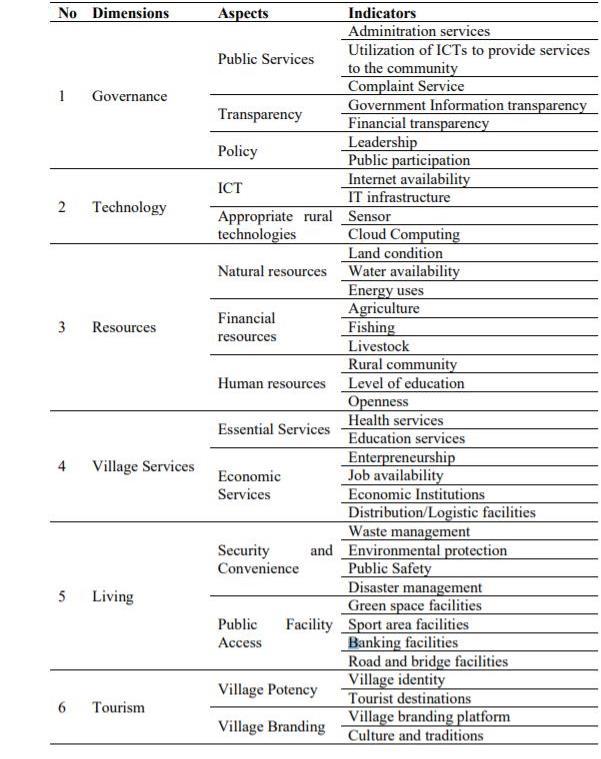
35 SMART VILLAGE 17011AA006
2.18 Housing
• Housing, or more generally living spaces, refers to the construction and assigned usage of houses or buildings collectively, for the purpose of sheltering people the planning or provision delivered by an authority, with related meanings.
• The social issue is of ensuring that members of society have a home in which to live, whether this is a house, or some other kind of dwelling, lodging, or shelter Many governments have one or more housing authorities, sometimes also called a housing ministry, or housing department.
• Super markets, kindergarten, parks, clubhouse, gym, swimming pool, general store, pharmacy, ATM, post office are the amenities should be provided for the people living in this housing
2.19 Group housing
Group housing means a group of houses for dwelling purposes and may comprise all or any of the following, namely:
• Adwelling unit
• Open spaces intended for recreation and ventilation;
• Roads, paths, sewers, drains, water-supply and ancillary installations, street lighting and other amenities; or
• Convenient shopping place, schools, community hall and other amenities for common use
Types of multi-storeyed buildings
•
Simplex apartment
The simplex is an apartment that has all its room on one level. Both the living and sleeping activity occur on the same level The close proximity of two activities, however, may be disturbing if they are not properly zoned. Major criticism for simplex has been the excessive amount of floor area required in corridors or stairs in order to gain access to the apartment.
•
The duplex apartment
The duplex apartment is an apartment that is located on two levels
Living room, kitchen and dining area on one level and sleeping area on the other level connected by an interior staircase The major economic advantage is the elimination of a corridor and elevator doorson every other floor.
•
Triplex apartment
The triplex apartment located on three different levels. Living room, kitchen and dining area connected by an internal staircase. This is restricted in high-rise apartment buildings. It is supported in the private luxury-type buildings.
36 SMART VILLAGE 17011AA006
2.20 Types of group housing
1. Row housing
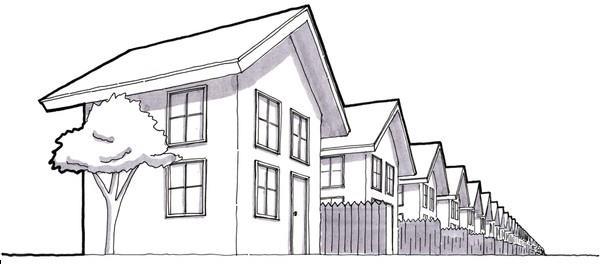
Row house is, as the name suggests, one of many houses in a row. The style is mostly found in densely populated urban areas, where space is limited The row house style has flourished for various reasons. For one, as cities grew, space becomes an issue Construction methods and financial benefits also contributed to the popularity of row houses, which have been around since the 1600s. They allowed builders to easily create homes, since they built several of them at one time.
2. Cluster housing
Cluster housing refers to a development in which homes are situated in groupings relatively close together, while larger areas of open spaces within the development form a buffer with adjacent land uses Often this is accomplished through small individual lots, with the remainder of the land becoming common ground.
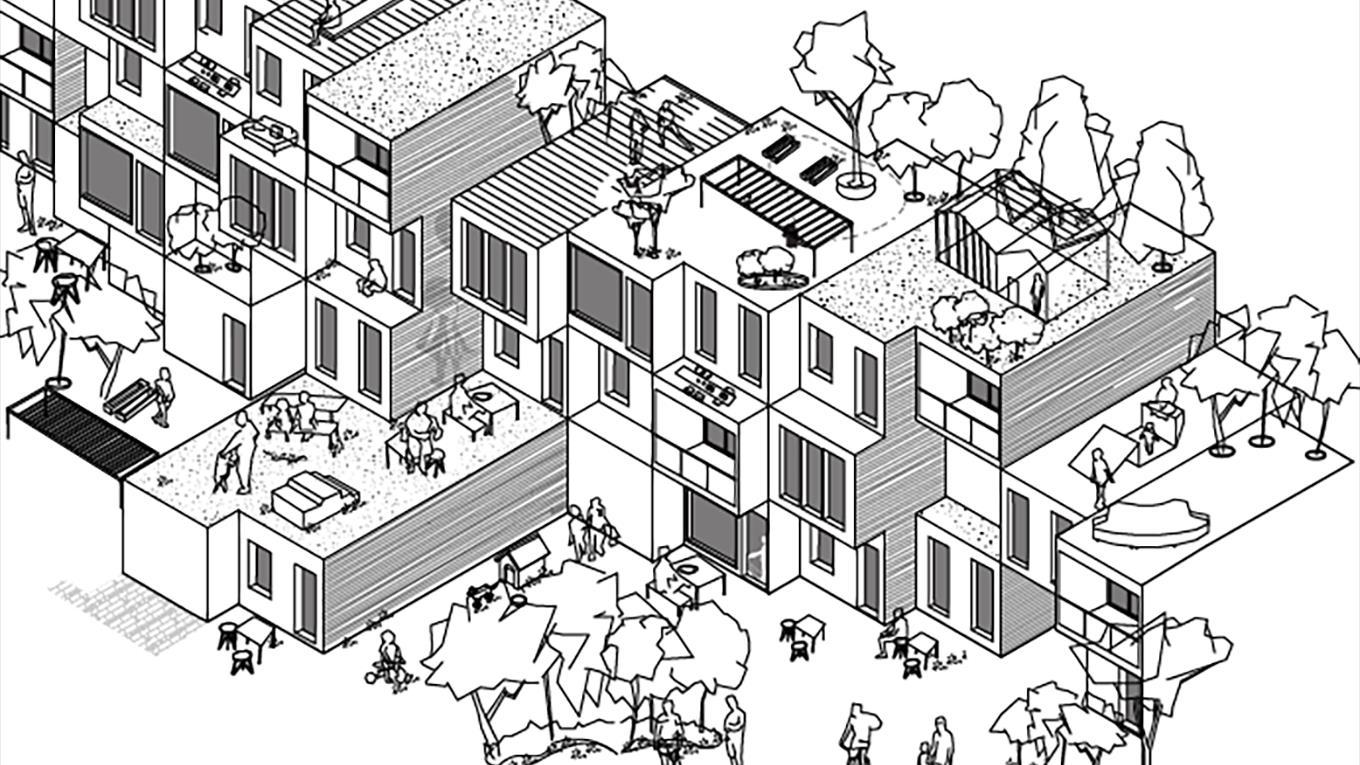
37 SMART VILLAGE 17011AA006
2.21 Street patterns:
1. Grid iron: Usually found in the oldest part of the city (CBD).This pattern is characterized by rectangular street blocks.


Problems:
• Many intersections that can cause traffic congestion
• Uninteresting design
• Can lead tolong and steeproads
Advantages:
• Easy to navigate around.
• Easy to extend streets.
• Easy to subdivide stands and to build.
2. Planned Irregular: Usually found at the latest suburbs and where there are steep slopes.
Problems:
• Difficult to extend streets.
• Can easily get lost.
Advantages:
• Interesting pattern.
• Dangerous with hidden entrances.
3. Radial:All roads lead to/out of a central point.
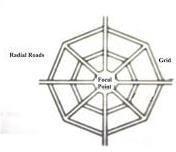
Problems:
• Unplanned growth can create traffic problems.
Advantages:
• Less intersections.
• Easiest flow of traffic.
• Aesthetic appeal.
4. Cobweb: Streetsradiate outwardsfrom one central point e.g. a plain, lake, dam, park.

38 SMART VILLAGE 17011AA006
2.22Affordable Housing
Introduction of affordable housing
• The definition of affordable housing is housing that is sufficient in quality, location and cost, which helps its occupants satisfy other essential living needs. In other words, the location, quality and build-up of a house is equally as important as the financial affordability of a household.
• There is no clear-cut definition of the term 'affordable', as it is a relative concept and could have several implied meanings in different contexts
• According to the RICS Report on Making Urban Housing Work in India, affordability in the context of urban housing means provision of adequate shelter on a sustained basis, ensuring security of tenure within the means of the common urban household.
• According to the Task Force on Affordable Housing set up by the MHUPA in 2008, affordable housing for various segments is defined by size of the dwelling and housing affordability derived by the household income of the population.
Different income groups and projected land required
• Affordable housing gets outlined actually in parameters of what reasonably social unit, in several income-ranges will do the affordability and if urban housing provided in market is in this price-range regardless of the standard of dwelling units An equivalent parameter applies to dwelling units for the poor sector. Since their affordability levels are terribly low, the non public real-estate trade provides them with dwelling units that is specified by little size, notgrunted tenure, nonexistent infrastructure and unhygienic-environment.

39 SMART VILLAGE 17011AA006
Also, few-availability of affordable housing is as much a tangle of the MIG groups as it is of the LIG As unable to seek out acceptable dwelling units as per their needs and wish, several belongings to MIG and Lower-MIG are forced to get substandard dwelling units Several of them encroaches cheap subsidized dwelling units provided by the government for poor individuals. Efforts to elevate living standards in the EWS/LIG, the difficulty of affordable housing must be checked out in a very comprehensive and analytic manner.
Definition and parameters of affordable housing
There is no-accurate outline of the term "Affordable". Therefore, this can be a comparatively kind of idea and might be having many-implied meanings in many relative contexts. "Affordability" in page of the urban-housing means that the providing of "adequate-shelter“ or "minimum-habitable area“ on a parameter basis, making certain security for tenure with-in the means that of the usually urban unit. In different straightforward definition, that affordable housing is that; dwelling units providing to those, whose needs don't seem to be meeting by the market.
Internationally, housing affordability is outlined in multiple ways in which. one in all the foremost normally accepted definitions of affordability refers to housing affordability which might be taken as a measure of housing expenditure to incomegroup within the family This is conjointly accepted by the Indian govt that states " affordable housing refers to any housing that meets some variety of affordability criterion, that might be income level of the family, size of the dwelling house unit or affordability in terms of EMI size or magnitude relation of house worth to annual income" [High-Level Task-Force on affordable housing for All, Dec - 2008, page. 7].
Whilst most of the definitions for affordable housing take into account the arearange, price-range, and affordability-range of the occupier, the key major ideas of constructing affordable housing go through providing adequate civic-amenities and appropriate-location stay unanswered. As per my analysis, affordable housing should be outlined as per builder's perspective on the idea of the subsequent criteria:
a) Necessity of minimum volume of habitation required for the income groups
b) Provision of amenities
c) Cost of house
d) cost of construction
e) Location of the house
f) High land-prices
g) Cost for purchases and transaction
h) Legal, Taxes and professional charges
i) Private operatorsand Profit margins
40 SMART VILLAGE 17011AA006
Affordability and its Concepts
"Affordability“ can be typically seen as a magnitude relation of value or rent of DU to the income of the social unit. The magnitude relation could disagree on completely different income-groups LIG will "afford to pay abundant less quantity of their earned-income for dwelling units expenditure than that of different income groups" "Deepak Parekh Committee“ reports outline the "affordability" magnitude relation for various income-groups as follows:
Cost of housing to income-expenditure ratio
It would be very applicable for us to filter out the EWS and LIG from the MIG/HIG. The quantitative relation of EWS is being down to no more than 20 % of EMI or Rent and three-times household's Total-annual financial gain for the value of the house, whereas keeping the "affordability" quantitative relation for LIG or MIG as given by the *"Parekh Committee“
There is a sub-category of urban poor that is additionally a part of governments inclusive-policy of providing AH for all specifically Below the Poverty-Line people. This section conjointly needs to be considered singly rather than as subpart of EWS The "affordability-level" of households in this specific category would be not more than five-percent of the earned-income. This sub-income class and its affordability levels will be outlined below:
To pay EMI/Rent (% of income)


41 SMART VILLAGE 17011AA006
Taking income-group classification on different income-groups are outlined by the GOI, the affordability levels shown below;
Affordable to pay EMI/Rent per month

It is understood that all kind of dwelling units in each income-category won't be concentrating at the upper end of the income-group “Affordability-levels" of mostly of the poor population could be much under what's being explained by the figures in Table 6 it's additionally quietly treated, that at given price-levels that cannot get a house in most of the Urban-Areas. Hence, it's quite necessary to outline the lower limits for every income-group category, in various to set up for providing of all lowest of income-group in every category. Additionally, "affordability“ is nevertheless to be outlined not solely in parameters of purchase price of the house possession or rent, however it should additionally embrace alternative charges and fees of registration and additionally searching cost etc. payable within the time of ownership and rental of the dwelling units. It ought to be additionally consisting of revenant price on the lifespan of tenure within the house These would come with legal taxes, maintenance price of dwelling units, utility price of dwelling units. It will be additional enclosed the "cost of commuting“ to the nearby workplace or would possibly different places by completely different priority of members of a family.
Demand and supply constraints

42 SMART VILLAGE 17011AA006
Affordable housing and its demand drivers
a) Urbanization:

It's an "index of transformation from traditional rural economies to trendy industrial one." India's urban population is expanding at a quicker rate than its population. At 28.83%, the spectrum of urban-growth in India has been slower than the typical spectrum of urban-growth in Asia sub-continent. Hence, absolutely the range of population in urban cities and cities has gone up incrementally In context, urban-growth could be delineated as a "by-product of demographic explosion and poorness induced rural-urban migration" This current scenario has resulted the pressure on urban- infrastructure and created increase within the population of homeless individuals living on the streets As per the 2011 census, the overall urban homeless population was 8, 87,600, which can be far more presently given the "inadequate-availability of cheap and low-priced housing“
Projected urban population by 2030
b) Raised income levels making a sizeable MIG segment:
In last decade years, have seen wonderful economic process within the region and also the implementations of one of the foremost successful "anti-poverty programs" within the Indian history. whereas 92 % of the gross population in year 1985 was beneath low category, this has been declined to 55 % of gross population in year 2005 and it's more expected to decline to 26 % the year 2025 Our economic-growth is additionally expecting to astonishingly amendment Indian income-slabs by making a “sizeable layer of MIG" Particularly MIG section is expecting to be the first driver for AH.
43 SMART VILLAGE 17011AA006
Share of population in each income bracket

The key supply constraints forAffordable housing
a) Land Availability:
It is one among vital questions escalated that Indian government to answer, that is with relation to the '"adequate supply" of land for "housing and residential purposes". The Govt. vision of-"Affordable Housing for All" would force land acquisition and yet as offer of huge land parcels on regular interval. As per 2011census, the Indian urban land-mass (3 % total land mass) homes around 28 83 % the Indian population, excluding EWS people that continue to exist the streets. As per calculations created by the "Town and Country planning Organization (TCPO)", to satisfy the demand of EWS or LIG category singly would need 85,835 to 130,892hectares of extra land price of land is another vital parameter touching the availability of land. the govt. is holding an enormous quantity of urban land underneath the possession of port trusts of India, the Railways lands, the Ministry of Defense lands, land being acquired beneath the Urban Land Ceiling and Regulation Act, the Civil aviation and Airports Authority of India and different government and nodal departments. this provides Rigid accessibility of land in Urban-location, it’s unviable for private developers to produce adequate cheap housing without Govt. backing.
b) Regulatory support and Finance:
This constraint has created limitation in Indian housing sector this funding for beneficiary's mechanism created within the country principally targets MIG and HIG income-groups of the society whereas the opposite class falling underneath LG and EWS category obtaining it troublesome to secure formal loan and housing finance private and commercial banks and traditional method of housing finance usually not entertain low-income groups, whose income is below the edge to confirm re-payment, or who cannot give certificate for securing housing loans Micro-finance-establishment are thought-about to be future best alternative for loan within the EWS and LIG category Further, there are several challenges are being featured by microfinance-institutions that do forestall them from extending housing loans munificently the main Challenges visage during this are primarily owing to the longer reimbursement amount of housing loans(minimum 5-7 years)
44 SMART VILLAGE 17011AA006
and another is because of the larger quantity of loan compared to typical loans that is extended by microfinance-institutions. yet one more drawback with microfinance establishments is of refinancing whereas "National Housing Bank (NHB)"give them with loan facility, however current interest rates are not-fixed and reviewed timely the shortage of developed debt-market, places add sizeable constraints for microfinance-companies, creating them of long-run availableness of affordable money as they presently able to manage money for a most.
Approvals from statutory-body adds24-30months to the Pre-Construction Process

Compression after removing regulatory and supply constraints

45 SMART VILLAGE 17011AA006
Affordable vs. Low- cost Housing
Affordable and low-priced housing area unit typically inter changeably used however are quite completely different from one another. Low-priced housing is mostly meant for EWS category and contains bare minimal housing facilities whereas Affordable housing is usually meant for LIG and MIG and includes basic amenities like primary-schools, multispecialty-hospitals and alternative community facilities and other civic-services.
Difference between low-cost vs Affordable housing

Schemes for affordable group housing in India:
Pradhan Mantri Awas Yojana (PMAY):
PMAY was launched in 2015 with the goal to provide 20 million housing units to the homeless by March 2022 At the end of its first phase, more than 1 crore such houses were already constructed and allotted to beneficiaries.
PMAY is divided into two parts, namely:
• PMAY Urban
• PMAY Gramin
As the names of these schemes suggest, the PMAY Urban aims at helping urban residents acquire proper housing. The PMAY Gramin scheme, on the other hand, is concerned with providing affordable housing solutions to rural area residents.
Some other schemes are:
• DAHousing Scheme
• Rajiv Awas Yojana
• NTR Housing Scheme
• Tamil Nadu Housing Board Scheme
• MHADA Lottery Scheme
46 SMART VILLAGE 17011AA006
The Need forAffordable housing
Affordability, especially in the Indian real estate sector, can mean a wide range of things. Specifically, the term holds different meaning for different categories of demographics. Further, there are also several socio-economic variables governing a city or location to consider. Generally, ‘affordable housing’ refers to residences that have been especially designed for the economically weaker section (EWS) and Lower Income Group (LIG) who are looking for the same comfort and security of a self owned property/home that the more fortunate middle class enjoys. In the earlier years of real estate development in India, the EWS and LIG categories did not get much attention to their needs However, with changes in administration and especially with the current government coming to power, a significant amount of changes has taken place in this respect These two sections make up the thickest segment of the demographic for India, and form the base of the country’s economy It has been overdue that their requirements are looked into Thankfully, there have been several initiatives by the BJP government under the leadership of PM Modi that have boosted affordable housing sector For example, it is seriously looking into the betterment of accessibility - read reduced commute times. Lack of accessibility has been one of the top reasons why low-cost housing was inaccessible. Even if such housing is outside of the main city periphery, improved connectivity makes distances shorter and such areas more viable and desirable as residential destinations.
Importance ofAffordable housing
Creating affordable housing is not just about helping a certain demographic to achieve their dream of home ownership. True, from a political viewpoint it is obviously important to cater to the demands of a massive vote bank. But there is an important economic angle to be considered, as well - the working class must have a good- enough reason to not move out of their city to be able to work and earn. It is important to understand that we are not just talking about people living on below or on the edge of the poverty line In 2012, the Housing and Urban Poverty Alleviation Ministry made an upward revision on the criteria that define EWS With this revision, families with an annual household income of up to Rs 1 lakh now come under the classification of Economically Weaker Section (EWS). This was a significant change from the earlier limit of Rs 5, 000/month or Rs 60,000 annually. The category of Lower Income Group or LIG also saw an upward revision - now, families with an annual income of between Rs 1-2 lakh came under the LIG category. Previously, the definition applied to families earning Rs 5001-10000/month or Rs 60000-120000 annually The people who fall under both these categories are extremely important for the country's economic progress. They provide myriad services which our cities can simply not do without, but are very prone to migrating out of cities which do not support their needs. For them, as for everyone else, home ownership provides not only a strong psychological anchor but also financial security and a better lifestyle - important incentives to stay put rather than migrate elsewhere.
47 SMART VILLAGE 17011AA006
2.23 Green Affordable Housing
Housing that is appropriate to the needs of a household and within their means to pay along with being environment conscious.
The means (or capacity) of a house-hold to pay for their housing depends on three primary factors:
• The income of the household
• The cost of appropriate housing; and
• Other essential living costs to be met by the household, such as food and household goods, transport, education and healthcare
IGBC
The Indian Green Building Council (IGBC), part of the Confederation of Indian Indus-try (CIl) was formed in the year 2001. The vision of the council is, "To enable a sustainable built environment for all and facilitate India to be one of the global leaders in the sustainable built environment by 2025.
Green Housing
• Green Housing is a type of housing designed to be environmentally friendly and sustainable.
• Focuses on efficient use of energy, water and building materials
• Type of housing that is built in order to conserve energy or water; improve indoor air quality; use sustainable, recycled or used materials and produce less waste in the process.
• Reduces or eliminates the adverse effect of buildings on environment and occupants.
• Environmentally responsible and resource efficient buildings are becoming an integral part and future of the construction industry.
• Sustainability in a real estate context is not only limited to energy conservation but also includes use of resources, impact on the surrounding environment and living conditions for the inhabitants.
• Green building incorporates sustainable features like efficient use of water, energy, use of renewable energy and recyclable materials, effective use of landscapes and building management systems
• Agreen building creates less waste and provides a healthier living environment.
• India's growing housing sector is one of the highest contributors to the country's carbon emissions accounting for 22% of India's total annual carbon emission.
• Buildings account for up to 40% of the total energy consumption in India, of which residential real estate accounts for over 60% of it. Hence, it is important to move towardsgreen housing.
48 SMART VILLAGE 17011AA006
Advantages of green housing
• Health and Wellness - Data from several researchers have shown that respiratory problems drop in green wildings.
• Environment friendly - Saves huge amount of resources like power and water, use of renewable resources for construction, waste efficiency, reuse and recycling, etc.
• Increased revenue - For both end user and developer Added cost of LEED (Leadership in Energy and Environmental Design) certification is about 2%-5% of overall cost of a building Developer can charge a premium for "Green Building" certification and the consumer will, in turn, have higher resale value and higher rental yields
• Lower Costs- Green building saves 30%-40% of the power consumption. Hence reduced electricity bills will bring in huge savings
• Government Incentives - Tax and premium rebates for buildings that meet certain minimum conditions under rating programs; many states in India offer incentives to developers by extra FSI.
• Marketing Tool - Builders can add Green Building certification to their list of credentials to attract more customers and investors, as well as draw interest to their projects.
• Environmental Benefits: Reduce wastage of water, conserve natural resources, improve air and water quality, protect bio-diversity and ecosystems
• Economic Benefits: Reduce operating cost, improve occupant productivity, create market for green product and services
• Social Benefits: Improve quality of life, minimize strain on local infrastructure, improve occupant health and comfort.
Site measures for green affordable housing
• Proximity to Public Transport 1P :
Encourage use of public transport, so as to reduce negative impacts caused from automobile use
Requirement of Public Transport : Locate the building within 1 km walking distance from an intra-city rail-way station(or) a bus-stop (or) other modes of public transport.
• Top Soil Preservation 2P :
Preserve excavated top soil and reuse later for landscaping applications thereby, reducing negative impacts to the site and surroundings.
Requirements: Preserve top 150 - 200 mm soil from excavation & reuse the soil for land-scaping purposes within the same site and plant vegetation to prevent soil erosion
49 SMART VILLAGE 17011AA006
• Access to Social Infrastructure 2P : Provide access to basic amenities, so as to reduce negative impacts caused from automobile use
Requirement 1 : Provide access to atleast six basic amenities within a walking distance of 1 km from the site entrance. Creche / School / Anganwadi, provisional store, clinic, pharmacy, primary health center /dispensary, ATM, entertainment zones, milk booth, saloon, parks, restaurant.
Requirement 2: provide the following within the campus: Seating facility and toilets in the common area for service staff & visitors minimum one toilet for every 200 dwelling units Tot-lot for children.
• Green Cover on-site - 15%, 20% , 15% - 1P, 20% - 2P: Minimise disturbances or re-store the site so as to reduce long-term negative environmental impacts, thereby promoting habitat and biodiversity.
Requirements: Provide vegetal / landscaping for at least 15% of total site area and Select plants, shrubs and trees which are local or adaptive species to the region.
• Heat Island Effect: Non Roof - 25%, 50% | 25% - 1P, 50% 2P : Minimise heat island effect so as to reduce negative impacts on micro-climate, human and bio-diversity.
Requirements: Provide one or combination of the following, for atleast 25% of exposed non-roof impervious/ hardscape areas within the project site: 1) Shade the footpaths, pathways, roads, uncovered surface parking and other impervious/ hard scaped areas with tree cover. 2) Install open grid pavers (or) grass pavers (or) light colored materials with solar reflective index (SRI) between 29-64
• Heat Island Effect: Roof- 75%, 95% | 75% - 1P, 95% - 2P: Minimise heat island effect so as to reduce negative impact on micro-climate, human and bio-diversity.
Requirements: Cover atleast 50% of the exposed roof areas with reflective materials with white surface applications (or) Light coloured China mosaic tiles
• Parking facilities for Tenements 1P: Provide adequate parking within the site to mini-mise disturbance caused due to parking on public roads, thereby, enhancing the quality of civic life.
Requirements: Provide parking on-site to cater two wheeler parking facility to each tenement.
• Design for Differently Abled 2P: Ensure that the building design caters to differently abled and senior citizens for their well being.
Requirements: Non-slippery ramps with hand rails on one side for access till main entrance. Provision of parking and toilet for differently abled as per NBC.
50 SMART VILLAGE 17011AA006
Water conservation for green affordable housing
• Availability of Potable Water 1P :
Ensure that households are provided with piped water supply to meet water requirements, so as to ensure that the community is habitable Requirements: Provide piped fresh water supply and storage system, considering per capita consumption of 90 litres fresh water per person per day
• Rainwater Harvesting -50, 75, 95% | 50% - 1P, 75% - 2P, 95% - 3P : Implement Rainwater management systems to enhance ground water table and thereby reducing dependence on potable water
Requirements: Provide rainwater harvesting system to capture atleast 50% of runoff volumes from roof and non-roof areas The harvesting system designed should cater to at-least 1 day of normal rainfall* occurred in the last 5 years.
• Water Efficient Plumbing Fixtures 3P :
Enhance efficiency of plumbing fixtures, there by minimising potable water use Requirements: Install all water taps with aerators and water closets with dual flush system 1) Aerators fitted for taps (in dwelling units), 2) Water closets with dual flush (in dwelling units), 3) Water efficient fixtures in common area toilets.
• Waste Water Treatment: 50%, 75% | 50% - 1P, 75% - 3P: Reduce consumption of potable water and waste water generation to minimise the burden on municipal water supply.
Requirements: Provide on-site waste water treatment system to treat minimum 50% of the waste water generated to reduce consumption of potable water: 2 points and Install in-situ Non-mechanical, Biological and natural ways of treating the waste water in STP's:1 point
• Treated Waste Water Reuse 2P : Encourage use of treated waste water to reduce dependence on potable water Requirements: Reuse the treated waste water on-site for reducing the dependency on potable water requirement Reuse of treated water for the following applications (1 point each measure, max 2 points): Flushing/ Landscaping Vehicle wash applications
• Management of Irrigation Systems 2P :
Reduce water demand for irrigation through water efficient management systems and techniques to reduce dependence on potable water Requirements: Provide or install highly efficient irrigation systems incorporating the features mentioned below (mini 4) : Central shut-off valve/ Turf and each type of bedding area must be segregated into independent zones based on watering
51 SMART VILLAGE 17011AA006
needs/ Sprinklers for turf areas/ Atleast 50% of landscape planting beds must have drip irrigation system to reduce evaporation/ Pressure regulating device(s) to maintain optimal pressure to pre-vent water loss.
• Water meters for dwelling units 1P : Encourage water sub-metering to improve the water performance in the project, and thereby save potable water Requirements: Provide water meters to all dwelling units
Energy conservation for green affordable housing
• Energy Efficient Building Envelope 4P :
Improve energy efficiency of the building(s)and system(s) to reduce environmental impacts from excessive energy use
Requirements: Implement efficient wall, roof, solar and glazing for building envelope measures to improve the energy efficiency. (1 point for each parameter)
• Shading Elements for Building Openings 2P : Incorporate passive architectural features to improve energy efficiency. Requirements: Implement shading devices over external openings and optimise
• Window to Wall ratio Efficient Lighting 2P : Enhance energy efficiency of the building(s) and system(s) to reduce environmental impacts from excessive energy use Requirements: Use energy efficient lighting fixtures to reduce the lighting power densities(LPD) in all interior, exterior, common and parking areas
• On-site Renewable Energy and Solar Water Heating Systems 2P : Promote self-sufficiency in energy through renewable technologies for on-site power generation and use within the project
Requirements: Install renewable energy systems for atleast 50 % of annual energy consumption for common area lighting (AND/OR) for Solar Water Heating, whichever is applicable
• Energy Saving Measures in Appliances & other Equipment 2P : Conserve energy in the use of appliances and other equipment, thereby reducing environmental impacts
Requirements: Provide the following : 1) Pumps: BEE 4-Star rated pumps or Minimum60% efficiency for pumps for capacity greater than 3HP and ISI certified pumps for others, 2) Motors: BEE 4-star rated motors (or) Minimum 75% efficiency for motors of capacity greater than 3 HP and ISI certified motors for others
52 SMART VILLAGE 17011AA006
Materials conservation for green affordable housing
• Separation of Household Waste : Facilitate segregation of house-hold waste at source so as to prevent such waste being sent to land-fills
Requirements: 1) Provide separate bins to collect dry waste (paper, plastic, metals, glass, etc ,) and wet waste (organic) 2) Additionally provide separate bins in a centralised/ common facility to collect waste such as e-waste, medical and paper waste.
• Organic waste management: 50%, 75% | 50% - 1p, 75% - 2P : Ensure effective organic waste management, post-occupancy, so as to prevent waste being sent to landfills
Requirements: Install on-site waste treatment systems Viz. dump-pits, organic waste converter or Vermi-Composting, etc , to treat atleast 50% of the organic waste generated and reuse them for landscaping needs.
• Handling of Construction Waste Materials: 50%, 75% | 50% - 1P, 75% - 2P : Encourage practices to manage construction waste, thereby, avoiding waste being sent to land-fills
Requirements: Avoid atleast 50% of the waste generated (by either weight or volume)during construction from being sent to land-fills.
• Use of Local Material: 50%, 75%, 95% | 50% - 1P, 75% - 2P, 95% - 3P : Encourage use of building materials available locally thereby minimising the associated environmental impacts resulting from transportation.
Requirements: 1) Source atleast 50% materials which are extracted and manufactured locally within a distance of 400 kms. 2) Survey and identify building materials which are in the specified distance, in early stages of project design
• Materials with Recycled Content: 10%, 20%, 30% | 10% -1P 20% - 2P , 30%
Encourage use of minerals which contain recycled content to reduce environmental im-pacts associated with the use of virgin materials,
Requirements: Use materials with recycled content such that the total recycled content constitutes atleast 10% of the total cost of the materials used in the building(s).
• Appropriate Technologies: 25%-1P, 50% -2P, 75% -3P, 95% -4P
Encourage use of appropriate and alternative construction techniques to conserve natural resources and thereby reduce environmental impacts.
Requirements: At least 50% (by cost) of the structure should be constructed using appropriate and cost effective technologies without compromising on strength,
53 SMART VILLAGE 17011AA006
durability &functional performance and encourage use of alternative technologies
• Alternative Construction Materials: 25%, 50% | 25% - 1P, 50% -2P : Encourage use of alterative construction materials to conserve natural resources and thereby reduce environmental impacts
Requirements: Atleast 25% of the alternative materials should be used in the building construction Indoor environment quality (IEQ) for affordable green housing
• Tobacco Smoke Control :
Minimise exposure of non-smokers to the adverse health im-pacts arising due to passive smoking, post occupancy.
Requirements: Smoking should be prohibited in all the common areas of the building.
• Day lighting: 75%, 95% | 75% -1P, 95% - 2P : Ensure connectivity between the interior and the exterior environment, by providing adequate daylighting
Requirements: Achieve a minimum glazing factor (GF) or lux level for all regularly occupied spaces.
• Fresh Air Ventilation: 50%, 75% | 50% -1P, 75% -2P : Avoid indoor pollutants by pro-viding adequate outdoor air ventilation, thereby enhancing the indoor environment quality
Requirements: Provide openable windows or doors and ventilators to the exteriors in all regularly occupied spaces of each dwelling unit such that the openable area is designed as outlined
• Cross Ventilation: 50%, 75% : 50%- 1P, 75% -2P :
Encourage adequate cross ventilation in the design thereby, providing a healthy environment.
Requirements: Provide openable doors / windows / ventilators to the exteriors in all regularly occupied spaces of each dwelling unit in atleast two of the orientations.
• Exhaust Systems 2P : Ensure that bathrooms and kitchen are adequately ventilated, soas to improve the quality of the indoor environment.
Requirements: Design exhausts systems in bathrooms as per the requirements.
54 SMART VILLAGE 17011AA006
• Low VOC Materials, Paints & Adhesives 2P :
Encourage use of materials with low emissions so as to reduce adverse health impacts on bulling occupants
Requirements: Use low VOC paints, sealants and adhesives to reduce adverse health impacts on building occupants
• Occupant Well-being Facilities 1P :
Provide occupant well-being facilities, so as to enhance physical, emotional and spiritual well-being of building occupants
Requirements: Demonstrate that the project has community well-being facilities of appropriate size (such as yoga/meditation room/ reading room or any gathering space and common seating spaces).
Innovation & design process for affordable green housing
• Innovative practices Credit 1 2P :
Provide design teams and projects an opportunity to attempt for innovative performance in green building categories not specifically addressed by the IGBC Green Affordable Housing Rating System
• Exemplary Performance Credit 2 Points: 2 Intent
Exemplary performance strategies result in performances that greatly exceed the performance level or expand the scope required by an existing Green Affordable Housing credit To earn exemplary performance credits, teams must meet the performance level defined by the next step in the threshold progression. For credits with more than 1 compliance path, an Innovation and Design Process point can be earned by satisfying more than 1 compliance path if their benefits are additive.
Building orientation for affordable green housing
• South orientation :
Sun will occur from late morning to early after room During summers the sun will appear high in the sky and during the winter months the sun will appear low in the sky. South orientation is the best to obtain the maximum sunlight during the day. Hot summer sun can easily controlled by properly designed overhangs. The low angle of the sun during the winter months will enable the rays to penetrate deep into the rooms.
55 SMART VILLAGE 17011AA006
• East orientation :
Sunlight will occur only in the morning hours so the early morning hours will have sun lighting The sun will be very low in the sky and sun will generally not be too intense. During winters, the sun will rise more towards the southeast, thus providing a shorter period of sunlight
• Southeast orientation : Sunlight will occur from the early morning to late morning, or possibly to noon, at midmorning the sun will be reasonably high in the sky and will provide a moderately intense sunlight.
• Southwest orientation :
Sunlight will occur from early afternoon to late afternoon The sun will be reasonably high in the sky. The rays of the sun will be more intense than the morning sun in some areas during the winter months the sun will set in the southwest.
• West orientation : Sunlight will be present from mid-afternoon to late afternoon. During the summer months, the west sun will be very intense. It will set generally in the west or north west During the winters The sun generally set in the southwest
• North orientation : No, sunlight will be obtained from a direct north orientation.
Room orientation for affordable green housing
• Individual room orientation to the sun is to a degree, a personal choice, but there are generally accepted orientation for different rooms within the dwelling unit
• Most frequently, it is very difficult to achieve the ideal orientation for each room and some compromises must be made
• It is beneficial to obtain some sunlight in the dwelling during day.
• A dwelling that is facing directly north and receiving no sunlight tends to be a cool or dreary dwelling.
56 SMART VILLAGE 17011AA006
2.24 Safetyperceptions
Listed below are five aspects of a gated community that make them safe for kids:
a. Street safety: Speed bumpers and lesser vehicular traffic within the walls of gated property make the streets of the community safer for kids to walk and play. The construction of the streets within the community is done keeping the welfare of children and their safety in mind, thus turning the streets in the area into comfortable zones for children to walk to school with their friends or ride their bicycles or play without worrying about possible speeding vehicles.
b. Parks and playgrounds: Today, there is hardly any place in urban centres for parks and playgrounds for kids, leaving them with no choice to turn to roads and streets for playing. This situation, in turn, causes worry to parents who fear about the safety of their kids in view of rash speeding vehicles. The presence of parks, playgrounds and recreation and sports facilities in many a gated community not only ensures quality time out of the house for kids but is also a relief for parents.
c. Well-planned layout: Gated properties are laid out in grids and numbered in an orderly manner. It makes it easier .for kids to make their way back home in case they‘re lost
d. Reduced community access: Most of the gated properties follow the no entry rule for vehicles entering the property This reduces the chances of endangering children‘s safety and prevents unauthorized people from walking in. Moreover, the community allows limited access, and people at the entry undergo thorough checks and cross-verification before they are allowed inside.
e. Reduced home access: A gate which remains closed with security personnel guarding it all the time, armed with communication equipment such as intercom is likely to make more people leave their kids at home peacefully if they have to attend to urgent work outside. Most of the gated communities have top-notch security that guarantees safety of kids when left alone at home or with older siblings or nannies.
57 SMART VILLAGE 17011AA006
2.25 Energy efficient design
▪
Energy efficient building design involves constructing or upgrading buildings that are able to get the most work out of the energy that is supplied to them by taking steps to reduce energy loss such as decreasing the loss of heat through the building envelope.
Basic principles of energy efficient design:
To achieve the right balance between – maximizing heat gain in winter, minimizing heat gain in summer, and minimizing heat loss in winter it is necessary to consider:
▪
The size of the home necessary to accommodate the number of people who are going to live in it.
▪
The orientation of the block to gain the best passive solar advantage.
▪ The type of building materials to be used.
▪ The best possible insulation to minimize heat loss in winter and heat gain in summer.
▪ The overall location and size of windows and/or external glass doors
▪ The location of windows and/or glass sliding doors on the north side of the home to get ben from the sun in winter
▪ Shading all north facing glass in summer.
▪
Minimizing east and west facing glass, and where necessary ensuring that it is full shaded externally during summer.

▪
Reducing south facing windows to cut back on excessive heat loss in winter
▪ The use of double glazing or low-e glass for south facing windows.
▪
Locating opening windows and/or sliding doors to allow cross ventilation to provide cooling effects in summer.
▪
Efficient lighting provision

58 SMART VILLAGE 17011AA006
03. DATACOLLECTION
59 SMART VILLAGE 17011AA006
3.1 Building rules and regulations
Floor Area
• Floor area is the sum of the gross area of the several floors of a building or buildings, measured from the exterior faces of exterior walls or from the center lines of walls separating two buildings.
• Minimum total floor area
i. For one person – 400 sq.ft. ii. For one person – 750 sq.ft iii. For one person – 1000 sq.ft. iv. For one person – 1150 sq.ft
v. For one person – 1400 sq.ft.
Floor Area ratio (FAR)
• It is the total floor area on a zoning lot. divided by the lot area of that zoning lot. FAR = total floor area/total lot area
• As per given site plan, FAR = 12 Total lot area = 20.000 sq.m Total floor area = 40.000 sq.m
Building Height & Setback
• The maximum height up to which any building be built shall not exceed the width of abutting road or street plus the width of the setback
• The width of front and rear set backs, if left at any point of the building, shall be equal to one-fourth of the height of the building(minimum 2m) & the width of the side back if left at any point of the building shall be equal to one-fifth of the height of the building (minimum 1 5)
• Given permissible height = 20m
Minimum height of the room, verandah & ventilation.
• The height of a habitable room shall not be less than 2.70m and the mean height of a water closet bathrooms, store room, gallery, verandah and mezzanine floor shall not be less than 2.25 and the clear head room in any case shall not be less than 2 25 meters
60 SMART VILLAGE 17011AA006
Ground coverage area
• Lot coverage is defined as the amount of structure that is covering the ground, or the "footprint“
• The area of projection shall not be counted towards the covered area
• Given coverage area = 40% (max.) = 16,000 sq. m
Parking
• The total area under parking is not to be less than 10% of the area of the site plus 10% of the area of the covered area on all the floors.
Staircase
• Every multi-stored building shall have provided with at least two staircase having minimum clear width of 1 20 metres
• No staircase in a building shall have a riser more than 22 cm and tread of less than 23cm
• The width of the landing shall not be less than the with of the staircase.
Light & Ventilation

• For daylighting of habitable rooms require at least one window opening or at least 10% of the floor area of the room.
• The percent of the area that will be openable ranges from 20 to 50percent.The most common specification is 45%
61 SMART VILLAGE 17011AA006
Residential andCommercial Zones
• In any layout or sub-division of land measuring 0.3 ha or more in residential and commercial zones, the community open spaces shall be reserved for recreational purposes which shall as far as possible be provided in one place or planned out for the use of the community in clusters or pockets.
• The community open spaces shall be provided catering to the needs of area of layout, population for which the layout is planned and the category of dwelling units
• The following minimum provision shall be made:
• 15 percent of the area of the layout, or
• 0.3 to 0.4 ha/1 000 persons; for low income housing, the open spaces shall be 0 3 ha/1 000 persons
Norms for planting ofshrubsand trees:
• Suitable provisions may be made for greeneries including plantations of shrubs and trees as part of environmental protection in general.
• This aspect shall be taken care of from the initial age of town and country planning, zoning and planning of development of particular area and group housing.
• The types of plants, the distance between trees/plants from the building and the distance between plants shall be carefully worked out keeping in view the structural safety and aesthetic requirements of building.
Widthof means of access:
• The residential plots shall abut on a publicmeans of access like street/road
• Plots which do not abut on a street/road shall abut/front on a means of access, the width and otherrequirements ofwhich shall be as given in Table.
62 SMART VILLAGE 17011AA006
Widthof
Access Length of Means of Access Max 6 75 7.5 150 9 250 12 400 18 1000 24 Above1000
Meansof
Residentialenclave as per HUDAnorms:
• The housing units may comprise of row houses, semi-detached, detached or apartment blocks or a mix or combination of both of the above.
• All group housing schemes/ group development schemes/ cluster housing/ residential enclave and row type development schemes shall be developed to the complete infrastructure facilities and amenities as follows
• The Building requirements would be as per the given type of housing.
• Residential enclave would be permitted only in those sites that give through access to minimum 9 peripheral road for the neighborhood plot or land that are located in the interiors
• They are governed by good design standards and not impinging on the overall accessibility and circulation network of the area.
3.2 Standard requirements ofa housing society
• Minimum size of the plot 4000 sq. m.
• The size of plot and height permissible as per type of respect to housing and requirements.
• Minimum common open space 10% of the site area.
• All building should not exceed 10 metres in height.
• The setback to be left from the periphery of the building block is 3 metres as different setback and to me as side setback
1.Pathways:
• Pathways should be laid in interlocking cement paying blocks.
2. Roads:
• Road should have a ridge of 50 mm sloping both ways and should have a provision for collecting of surface run off.
• Internalroad requirements: i. 9 metres to 18 metres from main internal approach road ii. 9 metres for the other internal roads. iii. 8 metres to cul-de-sac road between 50 to 100m length iv. 9m for looped roads.
63 SMART VILLAGE 17011AA006
3.Parapet
• Parapet walls and handrails provided on the edges of roof terraces, balcony, Veranda, etc, shall not be less than 1.0 m and not more than 1.2 m in height from the finished floor level
4. Plinth
• The plinth or any part of a building or outhouse shall be so located with respect to the surrounding ground level that adequate drainage of the site is assured. The height of the plinth shall be not less than 450 mm from the surrounding ground level. Every interior courtyard shall be raised atleast 150 mm above the determining ground level and shall be satisfactorily drained.
5. Interior courtyards and covered parking:
• Interior courtyard shall be raised at least 150mm above the determining ground level and shall be satisfactory drained
6. Mezzanine floor:
• Height: It shall have a minimum height of 2.2m.
• Size: The minimum size of the mezzanine floor, if it is to be used as a living room, should not be less than 9.5 metre square. The aggregate area of set measurement in a building shall in no case exceeds one third the plinth area of the building.
7. Sunshadesover windowsand ventilators:
• Projections of sunshades over windows or ventilators in existing built-up or congested areas when permitted by the Authority shall fulfil the following conditions:
i. No sunshade shall be permitted over the road or over any drain or over any portion outside the boundaries of the site below a height of 2 8 m from the road level; ii. Sunshades provided above a height of 2.8 m from the ground level shall be permitted to project up to a maximum width of 60 cm, if the road over which they project exceeds 9 m in width; and iii. No sunshade shall be permitted on roads less than 9 m in width or on roads having no footpaths.
64 SMART VILLAGE 17011AA006
Building norms and standards
SMART VILLAGE 17011AA006
Densities ( average)
2.
3.
4.
URDPFI
65
3.3
Densities ( average) Settlement types Persons per hectare Small towns 75 – 125 Medium towns 100 – 150 Large cities 125 – 175 Metropolitan cities 125 – 175 megapolis More than 200 Sr. no Types of development Range of densities 1. Plotted development 65-120plots per hectare.
Mixed development
Small towns 75-100 dwellings units per hectare.
cities 100-125dwellings units per hectare. 5. Metropolitan cities 125-150dwelling units per hectare.
NBC
SMART VILLAGE 17011AA006
Residential: Each
shall
size/frontage
Type of Development Dwelling unit sizes Typeof Development Plot Size (m2 ) Frontage (m) Detached building Above 250 above 12 Semi-detached building 125-250 8 to 12 Row type building 50-125 4.5 to8 No.of rooms Dwellingunit size (sqm) 1 BHK 60-80 2 BHK 80-120 3 BHK 120-160 4 BHK 160-200 5 BHK 200-260 66
Size of plots (NBC) ▪
plot
have a minimum
corresponding to the type of development as given below:
Set backs of a building (G.O. 168)

SMART VILLAGE 17011AA006
67
FloorArea Ratioand Coverage for Group Housing (NBC)
NOTE: The coverage shall be calculated on the basis of the whole area reserved for group housing.
68 SMART VILLAGE 17011AA006
Net Residential Density Dwelling Units/Hectare Maximum coverage percent FloorArea Ratio 25 25 0.50 50 30 0.75 75 33 0.90 100 35 1.00 125 35 1.25 150 35 1.50 175 35 1.75 200 35 2.00 225 35 2.25 250 35 2.50 275 35 2.75 300 35 3.00 325 35 3.25 350 35 3.50 375 35 3.75 400 35 4.00
MinimumSize andWidth of Different Componentsof Residential Premises:
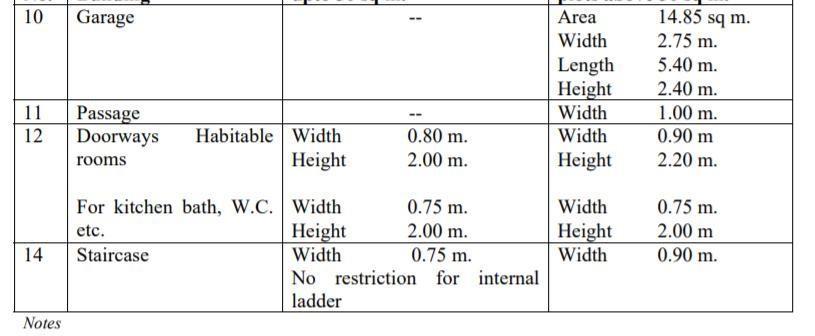
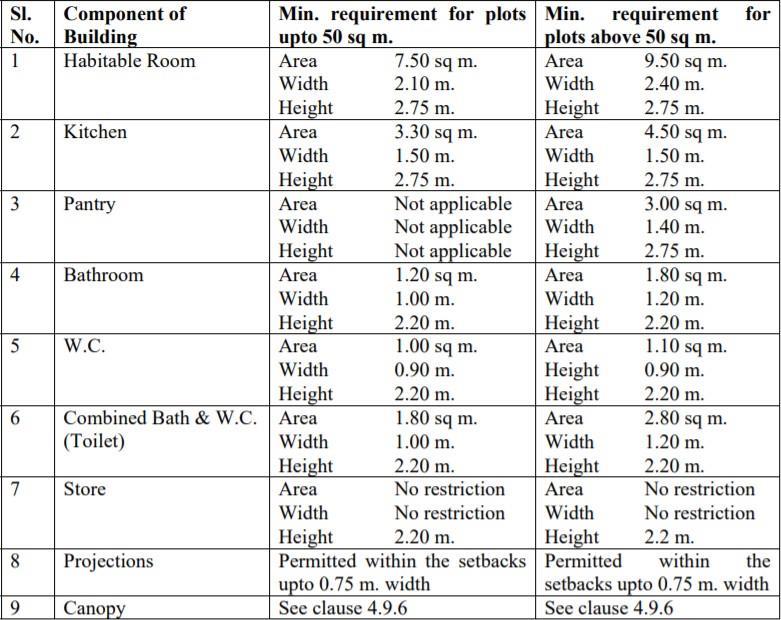
69 SMART VILLAGE 17011AA006

SMART VILLAGE 17011AA006
Height of the building (m) min. abutting road width (m) 21 12 21 – 24 12 24 – 27 18 27 – 30 18 30 – 35 24 35 – 40 24 40 – 45 24 45 – 50 30 50 - 55 30 G.O168 G.O168 s.no Height of buildings (m) Side and rear setbacks (m) 1. 10 3 2. 15 5 3. 18 6 4. 21 7 5. 24 8 6. 27 9 7. 30 10 8. 35 11 9. 40 12 10. 45 13 11. 50 14 12. 55 and above 16 URDPFI
70
Height ofthe building
3.4 Standards for different space components

Livingareas:
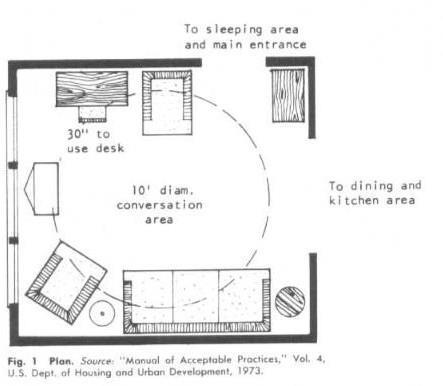
▪ To assure adequate space for convenient use of furniture in the living area, not less than the following clearances should be observed.
▪ 60 in between facing seating
▪ 24 in where circulation occurs between furniture 30 in for use of desk
▪ 36 in for main traffic
▪ 60 in between television set and seating
71 SMART VILLAGE 17011AA006
Planning Considerations::

▪
Through traffic should be separated from activity centres.
▪ Openings should be located so as to give enough wall space for various furniture arrangements.
▪ Convenient access should be provided to doors, windows, electric outlets, thermostats, and supply grills.
Furniture Clearances:
▪ 60 in between facing seating.
▪ 24 in where circulation occurs between furniture.
▪ 30 in for use of desk.
▪ 36 in for main traffic.
▪ 60 in between television set and seating. Seating arranged around a 10-ft diameter circle.

SMART VILLAGE 17011AA006
72
Combined living-diningspaces:
Combined diningarea-kitchen:


SMART VILLAGE 17011AA006 73
Furniture sizes and clearances:
▪
Sofa Sizes: 2'-8" to 3'-6" deep 6'0" to 7'-2" long.
▪
Love Seats: 2'-0" to 2'-10" deep 3'-6" to 4'- 6" long.
▪
End Tables: 10" to l'-2" wide l'-6" to 3'-0" long.
▪
Occasional Tables: 2'-0"to2'-4" square, round, oval, draw top,etc. ▪
Convertible Sofa-Beds: 2'-9" to 3'-3" deep, 6'-2" to 6'-8" long. ▪
Living RoomTables: l'-8" to 3'-0" wide, 3'-6" to 10'-0" long. ▪
Easy Chairs: Wing, 2'-4" to 2'-10" square; Club, 2'-4" to 3'- 3", 3'-9" square. ▪
Book Cases: 2'-6" to 3'-0" wide, 10" to 12" deep.
▪
Desks, Sloping Top: 3'-0" to 3'B" wide l'- 6" to 2'-0" deep.
▪
Writing Desks: 2'-8" to 3'-6" wide l'-6" to 2'-6" deep.


▪
Secretaries: 3'-0" to 5'-0" wide l'-6" to 2'-8" deep.

SMART VILLAGE 17011AA006 74
Diningareas:
Dining areas must accommodate furniture-either portable or built-in-for eating, sitting, serving and possible storage
Equipment for these dining functions may also be adapted to meet other possible requirements for this space-as studying, gameplaying, etc.
Table space requirements per person are as follows: for crowded seating, l'-10" on the table's perimeter; for comfort, 2'-0".
Adequate clearances for use are indicated on diagrams

Furniture Sizes:
Portable Tables, round 2'-7" to 5'-10" diam.
Portable Tables, rectangular (C): 2'-6" to 4'-0" by 3'-6" to 8'-0"; or 2',-0" to 4'-0" square
Dining Chairs, portable: l'-6" to 2'-0" by l'-6" to l'-10"
Serving Table: 2'-6" to 3'-6" by 1'-2" to l'-q"
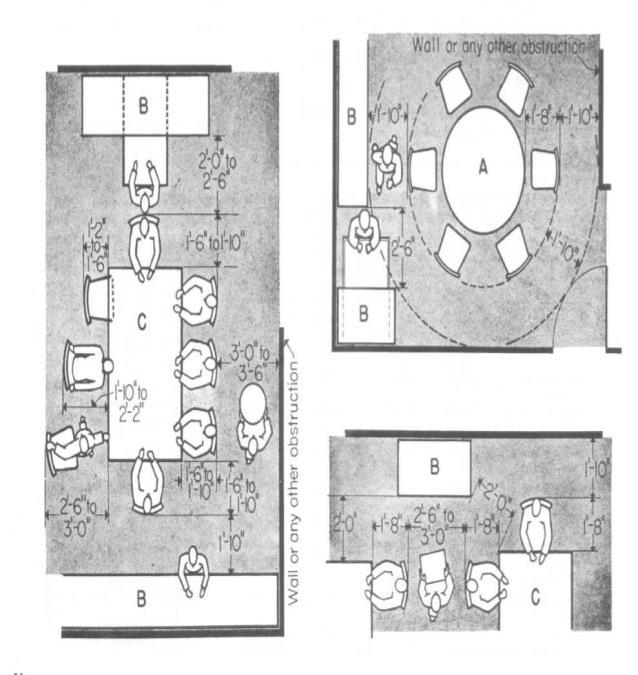
Sideboard or Buffet: 4'-0" to 6'-6" by l'-5" to 2’-I”
China Cabinet (B): 2'-8" to 3'-8" by l'-2" to l'-9"
SMART VILLAGE 17011AA006
▪
▪
▪
▪
▪
▪
▪
▪
▪
▪
75
Bedrooms
Beds:
▪
▪
Single, 3'-0" to 3'-3" wide; 6'-10" long.
Twin, 3'-3" wide; 6'-10" long.
▪ Three-quarter, 4'-0" wide; 6'-10" long.
▪
Three-quarter, large, 4'-2" to 4'-6" wide; 6'-10" long.
▪
▪
Double, 4'-6" wide, 6'-10" long.
Roll-away beds: 2'-0" by 5'-0" on edge, 3" clearance on all sides.
▪
▪
Bed tables: 1'-2" to 2'-0" by l'-0" to 2'-0"
Bedroom chairs: small, l'-8" by l'-8"; larger, 2'-6" to 2'-10" by 2'-8" to 3’-2”
▪
▪
Dressers (3-drawer): 3'-0" to 4'-0" by l'-6" to l'-10"

Chest of drawers (4-drawer): 2'-8" to 3'-4" by l'-6" to l'-10"
▪
Chaise longue: 2'-0" to 2'-4" by 4'-0" to 5'-6"
▪
▪
Day bed: 2'-9" to 3'-3" by 6'-2" to 6'-8"
Dressing table: l'-3" to l'-10" by 3'-0" to 4'-2"
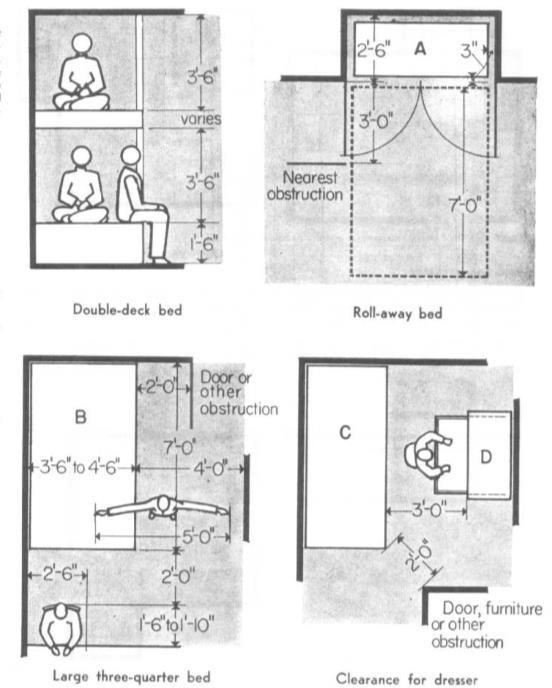
SMART VILLAGE 17011AA006
TSS 76
Bedrooms standards



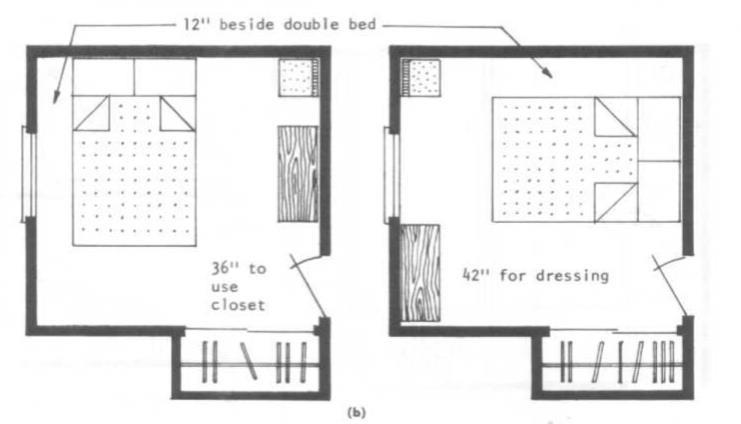
SMART VILLAGE 17011AA006
TSS 77
Kitchens
Height:
•
The height of a kitchen measured from the surface of the floor to the lowest point in the ceiling shall not be less than 2.75m, except for the portion to accommodate floor trap of the upper floor.

Size:
▪
The area of a kitchen with separate dining area is provided Shall be not less than 5 metre square with a minimum width of 1.8 metre where there is a separate store,the area of a kitchen may be reduced to 4.5 square. ▪
Akitchen, which is intended for use as a dining area also, shall have a floor area of less than 7.5 square with minimum weight of 2.1m.
Otherrequirements:
Every room to be used as kitchen shall have; ▪
Unless separately provided in a pantry means for washing of kitchen utensils which shall lead directly or through a sink to a grated and trapped connection to the waste pipe ▪
An Impermeable floor. ▪
Aflu, is found necessary ▪
Awindow on ventilator or opening
SMART VILLAGE 17011AA006
78
Kitchenstandards: TSS


SMART VILLAGE 17011AA006
79
Bathroomsand water-closets:
Height:
▪
The height of a bathroom or water closet measured from the surface of the floor to the lowest point in the ceiling shall not be less than 2.1m.
Size:
▪
The area of a mountain shall not be less than 1.8 metre with a minimum width of 1 2 metre the floor area of a water closet Shall be 1 1 metre square with a minimum weight of 0.9 is bathroom and water closet are combined, it's floor area shall not be less than 2.8 metre square with a minimum width of 1.2 metre.
Otherrequirements:
Every bathroomon water closet shall, ▪ Be so situated that at least one of its walls shall open to external air. ▪ Not be directly over or under any room other than another water closet, watching place, bathroom on terrace unless it has a watertight floor ▪ Have the platform of seat made of watertight non absorbent material. ▪ Be enclosed by what a partition and the surface of every search for partition should be finished with small impervious material to a height of not less than 1 metre above the floor of a room. ▪ Be provided with an impervious floor covering, sloping towards the drain with a suitable grade and not towardsveranda or any other room. ▪ Have a window on ventilator opening to a shaft or open space, of a not less than 0 3m with side not less than 0 3 metre
No room containing water closet shall be used for any purpose except as a lavatoxy and no such room open directly into any kitchen or cooking space by a door, window or other opening every room containing water closet shall have a door completely closing the entrance to it
SMART VILLAGE 17011AA006
80

SMART VILLAGE 17011AA006
82 TSS
81
Bathroom standards
Three fixture plans
Playlots
Playlots should be provided for preschool children up to 6years of age primarily in conjunction with multifamily (townhouse and apartment) developments and in single-family neighbourhood's remote from elementary schools. Playlots may include,
(1) an enclosed area for play equipment and such special facilities as a sand area and a spray pool;
(2) an open, turfed area for active play; end (3) a shaded area for quiet activities
• Location of playlots: Playlots should be included as an integral part of the housing area design, and are desirably located within 300 to 400 ft of each living unit served. The walkways there to should have an easy gradient for pushing strollers and carriages. Playlots may be included in playgrounds close to housing areas to serve the preschool age group in the adjoining neighbourhood
• Size of playlots: The enclosed area for play equipment and special facilities should be based on a minimum of 70 sq ft per child, which is equivalent to 21 sq ft per family A minimum enclosed area of approximately 2,000 sq ft will serve some 30 preschool children (about 100 families). Such a size will accommodate only a limited selection of play equipment To accommodate a full range of equipment and special facilities, including a spray pool, the minimum enclosed area should be about 4,000 sq ft, which would serve up to 50 preschool children (about 165 families).
• Playout equipment: The following table indicates types,
and minimum play space
for various types of equipment totalling about 2800 sq. ft
SMART VILLAGE 17011AA006
requirements
EQUIPMENT NO. OF PIECES PLAY SPACE REQUIREMENTS(FT) Climber 1 10 x 25 Junior swing set 1 16 x 32 Playsculpture 1 10 x 10 Play wall or play house 1 15 x 15 Sand area 1 15 x 15 Slide 1 10 x 25 Spraypool 1 36 x 36 82
quantities,
TSS
Playground:
▪
The playground is the chief centre of outdoor play for kindergarten and school age children from 5 to 12 years of age It also offers some opportunities for recreation for young people and adults.A playground may include,
a) a playlot for preschool children
b) an enclosed playground equipment area for elementary school children
c) an open, turfed area for active games.
d) shaded areas for quiet activities
e) a paved, multipurpose area.
f) an area for field games
g) circulation and buffer space
Size and number ofplaygrounds:

▪
Recommended size of a playground is a minimum of 6 to 8 acres, which would serve approximately 1,000 to 1,500 families
▪
The smallest playground that will accommodate essential activity spaces is about 3 acres, serving approximately 250 families (about 110 elementary school children).
▪ This minimum area should be increased at the rate of 0.2 to 0.4 acres for each additional 50 families.
▪
More than one playground should be provided where, (1) a complete school playground is not feasible (2) the population to be served exceeds 1,500 families. (3) the distance from the housing units is too great
SMART VILLAGE 17011AA006 83
PLAY SPACE
• Playground equipment: The following table indicates types, quantities, and minimum play space requirements totalling about 6,600 sq. ft; this area, plus additional space for circulation, miscellaneous elements, and buffer zones, will accommodate a full range of playground equipment serving approximately 50 children at one time. EQUIPMENT NO. OF PIEC ES
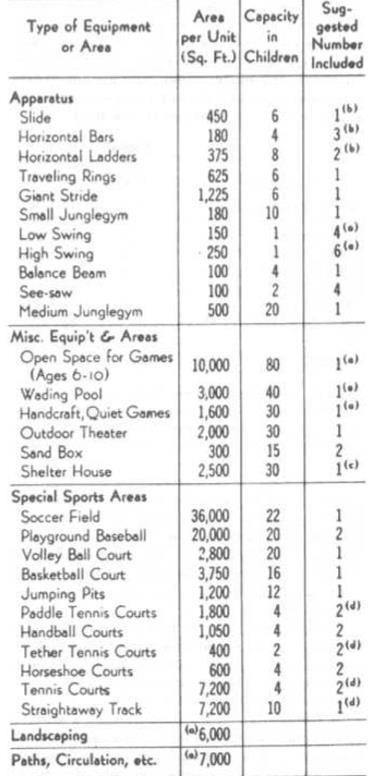
Balance beam 1 15x 30
Climbers 3 21x 50
Climbing pole 3 10x 20
Horizontal bars 3 15x 30
Horizontal ladder 1 15x 30
Merry-go-round 1 40x 40
Parallel bars 1 15x 30
Senior swing set 1 30x 45 slide 1 12x 35
SMART VILLAGE 17011AA006
REQUIREM ENTS (FT)
TSS 84
Pipe frame exercise unit:




Kindergartenswing (age 3 to 6):
Play swing (age 6 to 11):
SMART VILLAGE 17011AA006
85
Slide:
Circular play unit:

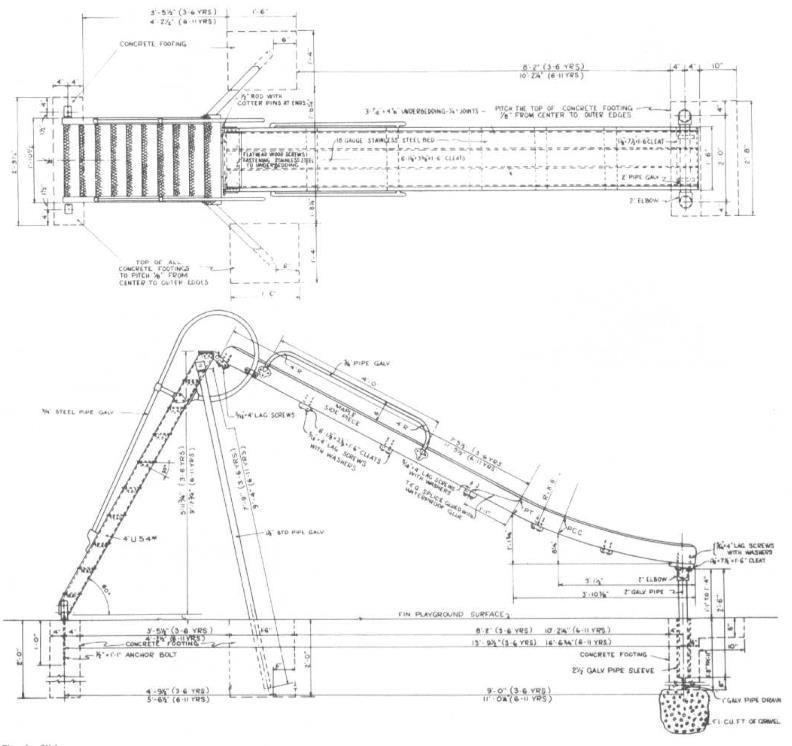
SMART VILLAGE 17011AA006
86
3.5 Survey of a village
• Village occupations basically constitutes of farming, service, business, dairy, poultry and others
• Monthly income of an average household in a village is Rs.2000/- to 5000/-
• Household possessions of an average villager are TV and two wheeler vehicles
• Average area of a house in a village is 130 sq.m
Characteristics Of Housing In Rural Areas
• In rural India, the building design, is influenced by the local building materials In places where stone is available in abundance as in Rajasthan, Gujarat and hilly areas like Himachal Pradesh, houses are constructed with stone walls and roof comprising of stone slab and slate etc. Bricks and tiles made out of local earth, are commonly seen in the houses of Uttar Pradesh, Madhya Pradesh, West Bengal, Bihar, Punjab, Karnataka, Tamil Nadu and Kerala. Timber and bamboo that are available in plenty in the mountains of States of Assam, Meghalaya, Tripura, Nagaland, Mizoram, Arunachal Pradesh and Manipur are liberally used for house construction
• Houses in rural setup are designed to meet the functional needs of the family. The average accommodation in a house is 2 or 3 rooms, small open space used as a kitchen and a court yard in front. Some big houses have central courtyard in addition to the front and back courtyard. A fair sized courtyard in front and more at the back is a feature in rural homes as household production is carried to a greater extent than in the urban areas This space is also used for activities like dairy, poultry and laying of kitchen gardens.
• Adequate provision is made for storing agriculture produce, fodder, implements and fuel or depending on the occupation e g weaver, carpenter, blacksmith –depending on the particular trade requirement.
• The floor is invariably made of stone in most of the homes. However huts are finished with rammed earth and plastered with cow dung
• Pucca houses have small windows and ventilators, while the others have small skylights or ventilators near roof. Natural light is made available mainly through doors and courtyard. The houses of poor families are generally dark, damp, and ill ventilated and use partially enclosed area within or outside to serve as bathroom.
• Protected drinking water facilities and closed drainage are still in scarce in
87 SMART VILLAGE 17011AA006
remote villages Most of the villagers depend on personal or community wells or local lakes for drinking water.
• Houses of affordable families have sanitary latrines connected to septic tanks or leach pits These are located away from main house to prevent contamination of ground water source. But the agony of moving out to open fields for defecation, continues till today in many villages.
• Garbage generated by the family is disposal into garbage pits which in turn is used as manure in the fields. In the houses of farmers, cattle waste is used for bio-gas plants to generate fuel and rich manure. Waste water from the kitchen and bathroom is diverted to the kitchen gardens
• The houses are designed to provide for future expansion (in case of small rooms) as and when the need arises.
Common features of housing typology in a village
1. Large houses with over 1oo Sq. mts built area.
2. New houses are smaller with built up area varying between 50 to 70 Sq.mts.
3. All houses are single storied
4. Old Houses have internal court Yard
5. New additions do not have internal CourtYard pattern
6. Old construction has load bearing mud walls of 01 mt. thick
7. New construction is of 23cm thick load bearing brick wall
8. Old houses have local country tile roof supported over wooden trusses
9. New houses have flat R C C or R B C roof
10. Due to mud wall construction old houses have room span not exceeding 02mts.
11. New houses have room span over 03mts.
12. Old houses do not have proper windows and suffer from adequate light and ventilation
13. New additions as well as new houses have proper windows
14. Old houses have cattle sheds attached
15. Pit latrines are not attached to houses, but are separately located nearby.
88 SMART VILLAGE 17011AA006
Survey on housing & infrastructure housing satisfaction
• Need for additional space
Yes : 24 (85.71%) no : 04 (14.29%)
• Extension of house for additional space
Possible : 26 (97.86%) Not possible : 02 (07.14%)
• Type of structure
Permanent / Pukka : 02 (7.14%) Temporary/Kaccha : 17 (60.71%) Mixed : 01 : (03.57%)
• Roofing (house)
RBC/RCC : 00 (0%) Tin Shed : 02(07.14%) Thatched: 16 (57.14%) Mixed : 11(39.29%)
• Roofing (animal sheds)
RBC/RCC 00 (0%) Tin Shed : 02(07.14%) Thatched: 24 (85.71%) Mixed : 01(03.57%)
• Roofing (store)
RBC/RCC 00 (0%) Tin Shed : 00(00 %) Thatched: 23 (82.14%) Mixed : 01(03.57%)
• Walling materials (house)
Brick/cement: 08 (28.57%) Brick/mud : 05 (17.86%) Mud : 13(46.43%) Others :02(7.14%)
• Walling materials (animal shed)
Brick/cement: 01 (3.7%) Brick/mud : 05 (17.86%) Mud : 00(00%) Others :21(75%)
• Walling materials (separate store)
Brick/cement: 00 (00%) Brick/mud : 05 (17.86%) Mud : 20(71.43%) Others :00(00%)
• Water supply
Hand pump : 14 (50%) Well : 12 (42.86%) others : 02(7.14%)
89 SMART VILLAGE 17011AA006
04. DESKTOPSTUDIES
90 SMART VILLAGE 17011AA006
4.1 Desktop study 1 –Auroville
Auroville, City of dawn is a universal township in the making for people from around the world, The purpose ofAuroville is to realize human unity.

The concept of Auroville - an ideal township devoted to an experiment in human unity - originated from Mirra Alfassa ‘The Mother’ who was spiritually related to India in1930s.
Auroville is located in south India, in the State of Tamil Nadu (some parts are in the State of Puducherry), a few kilometres inland from the Coromandel Coast, approx 150 kms south of Chennai and 10 kms north of the town of Puducherry

91 SMART VILLAGE 17011AA006
Location : Tamil Nadu, India
Site area : 20 square kilometers approx.
Population : 2814
Founder : Mirra Alfassa
Architect : Roger Anger
Climate : sub-humid tropics (wet-and-dry tropical climate)
• Auroville was founded as a project on experimental basis of the ‘Sri Arbindo Society’ on Wednesday 28 February 1968.
• Mother envisaged Auroville as an international township for 50,000 residents on the shape of a flower
• Architect Roger Anger refined the planning and designed it in shape of Universe. He placed Matrimandir at the center of this city.
• Mirra Alfassa in her first message regarding the town stated that, "Auroville is meant to be a universal town where men and women of al countries are able to live in peace and progressive harmony, above all creeds, all politics and all nationalities”
• Construction materials used are mainly organic and natural including wood, mud, grass, stabilized earth bricks and fired bricks.
• Most of these homes have sustainable energy systems such as solar
Concept
The Galaxy concept of the city
In terms of physical development, Auroville aims at becoming a model of the 'city of the future' or 'the city the earth needs'. It wants to show the world that future realisations in all fields of work will allow us to build beautiful cities where people sincerely looking towards a more harmonious future will want to live.
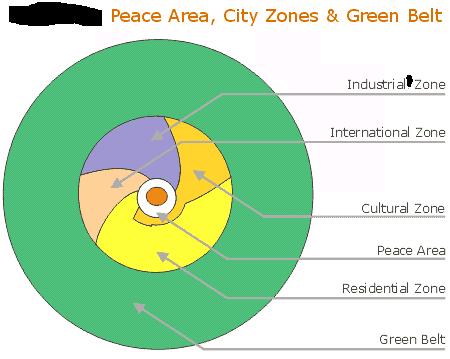
92 SMART VILLAGE 17011AA006
In her 1965 sketch of Auroville, the Mother laid down the basic concept for the city. This sketch delineated all the important activity areas that would fulfill the vision of making it a universal city. For other things she gave a free hand to Roger Anger, the French architect she had appointed to oversee the city's physical development.

• At the center stands the Matrimandir, the “soul of Auroville”, a place for individual silent concentration Surrounding the city area is a Green Belt consisting of forested areas, farms and sanctuaries with scattered settlements for those involved in green work
• Radiating out beyond the Matrimandir Gardens are Four Zones, each focusing on an important aspect of the township’s life:
1. Industrial (north)
2. Cultural (north east),

3. Residential (south/southwest) and
4. International (west)
TheAuroville Charter
1. Auroville belongs to nobody in particular. Auroville belongs to humanity as a whole But, to live in Auroville, one must be a willing servitor of the Divine Consciousness.
2. Auroville will be the place of an unending education, of constant progress, and a youth that never ages.
3. Auroville wants to be the bridge between the past and the future Taking advantage of all discoveries from without and from within, Auroville will boldly spring towards future realizations
4. Auroville will be a site of material and spiritual researches for a living embodiment of an actual human unity.

93 SMART VILLAGE 17011AA006
Design evolution
• In interviews with Auroville Today in 1988 and in 1992, Roger Anger explained how this plan came into existence. "Mother had given a couple of parameters: the division of the city into four areas, or zones, and the number of people for whom the city is envisaged (50 000)
• The division into those four zones (industrial, residential, international and cultural) is unique, and has no precedent in town planning.
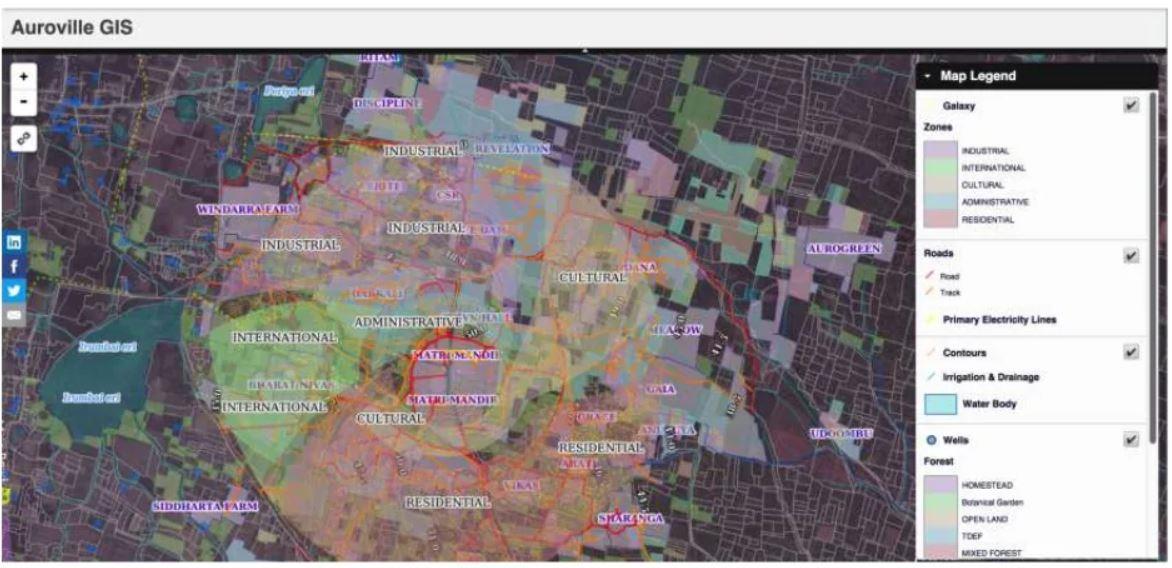
• On the basis of this scheme, the architects and town planners, started to make suggestions to her. This was done in several stages, and finally the Galaxy came out and was presented as a model to Mother, and accepted by her as a plan that answered to her parameters. She inspired and guided the work. When I talked to Mother one day about Auroville, she said that “the city already exists in a subtle level, that it is already constructed, that it is only necessary to pull it down, to make it descend on earth “
• The galaxy plan shows the four zones, which are interconnected through the 'Crown', the second circular road around the Matrimandir.
• From the Crown, twelve roads radiate outwards as part of the infrastructure. Some of them are accompanied by a succession of high-rise buildings, which constitute the so-called 'Lines of Force', essential for the framework of the city and for the integration of all access to the city center. But the plan is not finished On the contrary, the city is still to be invented, everything has still to be done through the daily experience and rhythm of theAurovilians.
• Apart from these lines of force, everything is flexible, nothing is fixed.”
Planning
94 SMART VILLAGE 17011AA006
Master plan ofAuroville

On going development plan ofAuroville

95 SMART VILLAGE 17011AA006
Zoning
•
Peace Area
At the centre of the township lies the Peace Area, comprising the Matrimandir and its gardens, the amphitheater with the Urn of Human Unity that contains the soil of 121 nations and 23 Indian states, and the project of a lake to help create an atmosphere of calm and serenity and to serve as a groundwater recharge area


•
Residential Zone
The largest of the four city zones, comprising of 189 hectares, the Residential Zone is bordered by parks on the north, south and west. Main access to the zone will be through the crown road with further traffic distribution via five radial roads that divide the zone into sectors of increasing densities. This zone wants to provide a well-adjusted habitat between individual and collective living 55% of the area will be green and only 45% built surface, thereby creating an urban density balanced by nature
•
Industrial Zone
A 109-hectare area to the north of the Peace Area, the Industrial Zone, a zone for "green" industries, is focused on Auroville's efforts towards a self-supporting township It will contain small and medium-scale industries, training centres, arts and crafts, and the city's administration.
•
International Zone
The International Zone, a zone of 74 hectares to the west of the Peace Area, will host national and cultural pavilions, grouped by continents Its central focus is to create a living demonstration of human unity in diversity through the expression of the genius and contribution of each nation to humanity
•
Cultural Zone
Planned on a 93-hectare area, situated to the east of the Peace Area, the Cultural Zone will be a site for applied research in education and artistic expression. Facilities for cultural, educational, art and sports activities will be located in this zone.
96 SMART VILLAGE 17011AA006
• Green Belt
The city area with a radius of 1.25 km. will be surrounded by a Green Belt of 1.25 km width. As a zone for organic farms, dairies, orchards, forests, and wildlife areas, this belt will act as a barrier against urban encroachment, provide a variety of habitats for wildlife, and serve as a source for food, timber, medicines etc and as a place for recreation

Presently an area of 405 hectares, the Green Belt - though incomplete - stands as an example of successful transformation of wasteland into a vibrant eco-system. Its further planned extension with an additional 800 hectares will make it into a remarkable demonstration site for soil and water conservation, ground water recharge, and environmental restoration As lungs for the entire township, it will complete the healing process thatAuroville started several decades ago.

Regeneration Eco system services
Before After
97 SMART VILLAGE 17011AA006
•
•
•
•
•
•
•
•
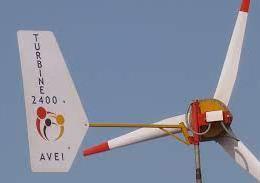

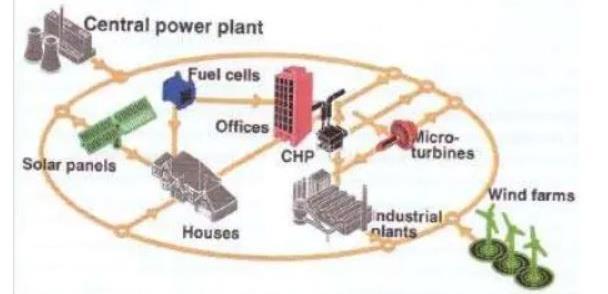




Distributed energy generation 98 SMART VILLAGE 17011AA006
energy generators
Renewable
Stand-alone solar PV systems
Wind turbine
Roof top solar PV panels
Solar bowl Energy management
Pioneered Grid-Connected Solar PV in Tamil Nadu and Puducherry
Support to policy makers and regulators (e.g. solar net metering)
In-house PV monitoring system (Wattmon)
First micro-grid with virtual net-metering Distributed energy generation Before After Wind turbine Connected grid Solar bowl Solar PV systems Solar panels




99 SMART VILLAGE 17011AA006 Other services
Electric vehicles
EV Charging points
Water management
Waste management Electric vehicles EV Charging points Waste management Rain water harvesting Waste water management Water management
•
•
•
•
4.2 Desktop study 2 – Sunflower Village
Valentino Gareri Atelier Proposes a New Model of 3D Printed Residential Village
Valentino Gareri Atelier have joined forces with technology and wellness consultant Steve Lastro of 6Sides and global wellness real estate innovators Delos to create Sunflower Village, a humanistic and sociological approach to residential technology & community living. The proposed residential village includes 19 homes arranged in a sunflower composition that 'follows the sun’. It is designed as "a new model of sustainable community village", envisioned for low density and rural areas
Objective
According to the team, their project comes as a response to the amount of people who wanted to escape high-dense urban cities during the pandemic, and felt encouraged by the newly-imposed working-from-home policies. The pandemic also encouraged a new ways of working, which has largely increased working-from-home friendly policies. This shift from big cities to small rural towns proved how it became necessary to rethink about these overlooked areas and define a "new model of city for the post-pandemic future".
Concept
For a general layout, the architects take cues from a sunflower, the arrangement of the houses ‘follows’ the sun circle, where the lots and houses are radially distributed around a central communal area.
Photovoltaic roofs are shaped and angled in order to receive direct clean energy from the sun, as a sunflower does in nature every day.
The 19 homes are designed as singular-story houses that are built by using 3dconcrete-printing technology, while the adopted construction process naturally shapes the final urban form.

100 SMART VILLAGE 17011AA006
"History tells us that new materials and construction techniques had always influenced the forms of the buildings Each of the most significant architectural forms has been aided by the discovery of new construction method," added Valentino Gareri Atelier
Design strategies
1. Each house is designed to be energy self-efficient, not only due to their orientation, but also due to photovoltaic frameless tiles that are clad onto the angled roofs.
2. The roofs, like a sunflower, are angled to ‘follow’and catch the most efficient amount of solar radiation, according to the site latitude. The clean energy is collected in batteries and utilized for the floor-heating system, for airconditioning, and for electric cars alimentation.

3. Moreover, the roof inclination, promotes the rain water collection, aimed to be used for toilets and irrigation, into a water tank located in the service room.
4. The house geometry, arrangement, and orientation promote and increase the chimney effect of natural ventilation, reducing the need for automated airconditioning
5. PV panels are allocated only on the roofs which have the best sun orientation, the energy accumulated is shared with the whole village, and the facades are treated in order to achieve the best performance according to the solar orientation
6. Here the height of the building is reduced to the minimum necessary, saving material to be utilized in the opposite site of the building, where the height is increased to maximize the view towards the countryside.
101 SMART VILLAGE 17011AA006
“The 3D printing technology will give form to the city of the future.”
Construction process
• The construction site is placed in the center, allowing the concrete-printer machine to move through extendable and flexible binaries to print all the houses

• Due to a temporary placed turning-table, the houses are printed in sequence by rotating in the central site. Less soil is consumed during the working phase, which makes it an even more sustainable construction process.
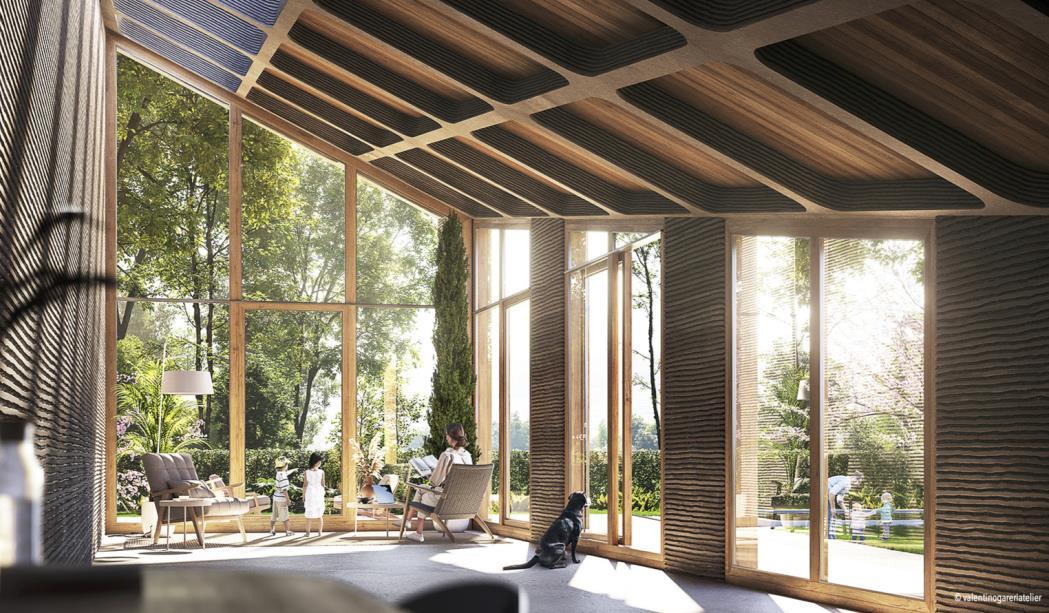
102 SMART VILLAGE 17011AA006
Renders of housing unit in Sunflower Village
Anew model of living together
Design evolution

Proposed housing unit of sunflower village
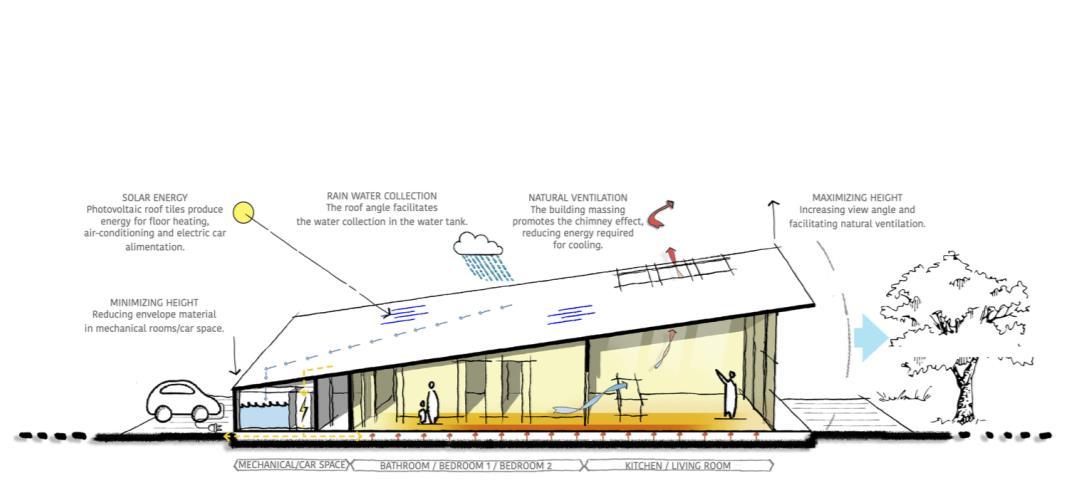

103 SMART VILLAGE 17011AA006
The energy self-sufficient houses, immerse and completely open to nature, are designed as sustainable ‘machines’where the final shape is the result of scientific criteria that have the aim to save or produce energy


Since wellness is at the forefront of Sunflower Village, each home is fitted with DARWIN Home Wellness Intelligence by Delos, "the world’s first holistic inhome wellness platform that is designed to passively enhance human health and well-being through air purification, water filtration and lighting that mimics natural daylight"
The circular configuration provides a more sustainable way of connecting the units, providing a strong sense of community and reducing the amount of necessary roads and vehicles. This newly-proposed living module can be translated onto other public functions such as schools, kindergartens, and public civic centers. The combination of more villages forms a new multi-centric urban configuration and a new model of city of the future, characterized by a strong sense of community.
Architecture has the power to create places that don’t exist yet, but in our dreams. ‘Sunflower’ is the model of the city we dream for tomorrow.
Valentino Gareri
104 SMART VILLAGE 17011AA006
4.3 Desktop study 3 – Odanthurai, Tamil Nadu
We are going to talk about one of the smartest villages of India called Odanthurai Gram Panchayat, where electricity gets generated.
Location

Panchayat is situated on northern bank of the river Bhavani, opposite to Mettupalayam on the southern bank It is situated 40 kilometers north of Coimbatore in Tamil Nadu along the Coimbatore-Ooty highway.

The village has a population of 5,399 The total geographical area of village is 1199.95 hectares. There are totally 1050 dwelling units in the Village Panchayat of Odanthurai In a country where villages are still struggling with inadequate power supply and expect the government to fix the problem, self-powered Odanthurai has set an example by producing its own green power for its needs The Village Panchayat is a heterogeneity demography having multi community and multi religion comprising of Backward, Most Backward, Scheduled Caste and Scheduled Tribes and religion of Hindus, Muslims and Christians.
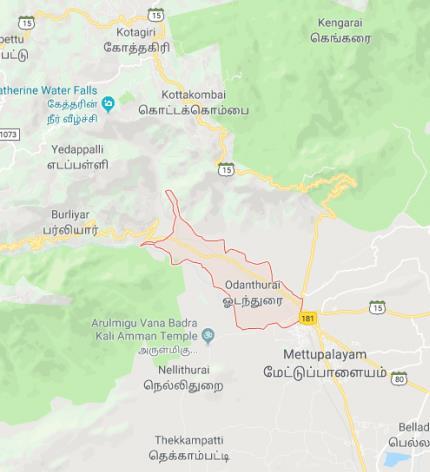
105 SMART VILLAGE 17011AA006
The initial condition of development in the village was worse and people lived in extreme poverty without even a place to live. Almost all the families lived in huts, struggled in hand to mouth existence, lack of employment, lack of basic amenities like drinking water, health and sanitation, non-availability of school building and electricity.

1996 2015
Keeping the above thoughts in mind, the president of Odanthurai village panchayat determined to serve the people by providing good administration without corruption, and executing the government schemes with people’s participation and maintain transparency and accountability At present, after the intervention strong leadership by Mr. Shanmugam, President of the village panchayat, there are two primary schools, one middle school, two matriculation schools functioning with all adequate facilities.
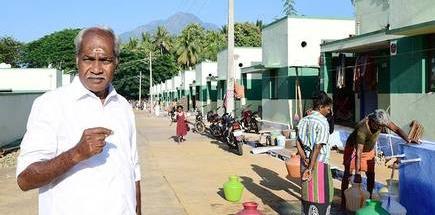
106 SMART VILLAGE 17011AA006
Mr. Shanmugam, President of the village panchayat,
Housing Solar panels

No wonder, when elsewhere people migrate to cities and town, it is the other way around at Odanthurai. Good and copious water, pucca roads and houses, and a pollution-free environment seem to draw people to move to the villages.

107 SMART VILLAGE 17011AA006
Inspiring self-powered village – Odanthurai
1. The most notable among Odanthurai’s self-help ventures is the 350-kw wind power generator that was set up in 2006 under the direction of a well functioning gram panchayat. The wind-farm/ windmill in the Odanthurai generates 7 5 lakh units of electricity in a year While the panchayat’s need is only 4.5 lakh units, the remaining power is sold to the Tamil Nadu Electricity Board, fetching an annual income of INR19 lakh “After repaying the bank loan of INR1.15 crore over seven years, the cost of generating electricity will be virtually zero,” beams Shanmugam, Panchayat President.

2. Odanthurai Panchayat has made inroads in other renewable sources of energy as well It has installed a 9kW biomass gasifier power generation system to substitute the grid electricity for pumping drinking water. The biomass gasifier system saves about 70% of pumping cost as compared to grid electricity. The panchayat is purchasing waste wood pieces from a saw-mill in the village at low price of INR0.3/kg as fuel of the gasifier. Low demand for waste wood for cooking purposes might have contributed for such a low price.
3. Other renewable energy projects underway are solar street lighting and biogas using human and cattle excrement. The biogas system is connected to each house for cooking purpose, which helps to reduce firewood usage
108 SMART VILLAGE 17011AA006
Wind mill
Summary of Odanthurai panchayat’s gasifier system
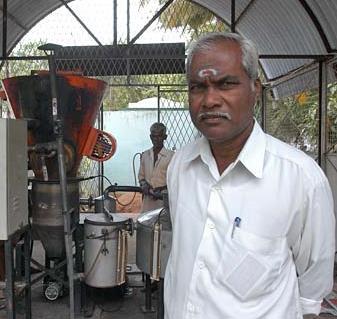
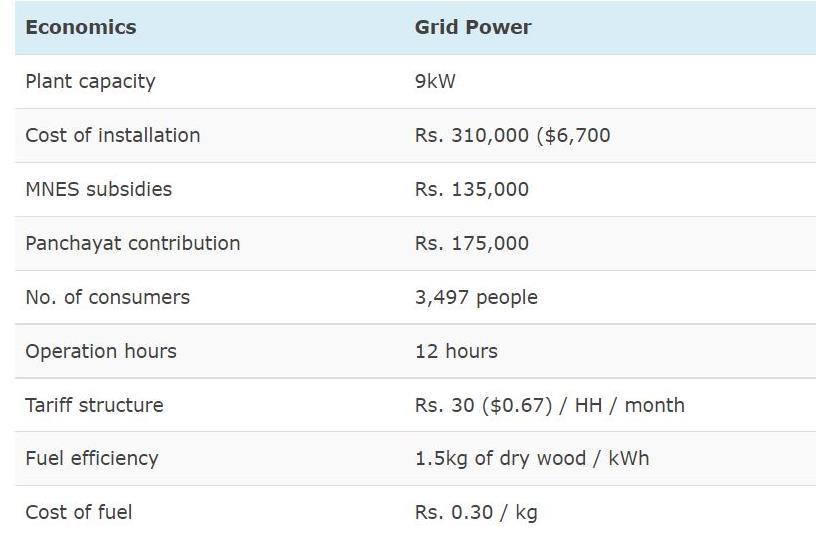
Biomass gasifier
Achievements of Odanthurai Gram Swaraj
Odanthurai panchayat, attained 85% growth in ten years. The landmark of the Panchayat are listed here
Road
• Conversion 4 km mud road in to black top road.
• Converted 9 km mud road into black top pucca road.
• Construction of 2 kms internal roads with panchayat fund.
• Laid 2 Kms metal road in Naripallam Road
• Constructed small bridge and laid approach roads to the farmers under Infrastructure scheme.
Housing
• The panchayat constructed around 1400 houses under the housing scheme There were just about 250 houses during the year 1996. Today, there are over 1,650 houses
• Constructed 173 houses for houseless Adi Dravidas
• Constructed 115 kutcha houses for Tribal people & 32 houses for BC families’ people under IAY Scheme.
• Constructed 290 cluster houses with 40 SOLAR STREET LAMPS
• Bio-Gas plant linked latrines in Vinobaji Nagar.
Drinking Water
• Dug bore wells and constructed overhead tanks in seven villages for adequate and regular supply of drinking water to all households
• Initiated RAJIV GANDHI NATIONAL (PEOPLE CONTRIBUTION) DRINKING WATER SCHEME, with people contribution of 48 lakhs for installing of water purification from Bhavani river and supply to habitants.
109 SMART VILLAGE 17011AA006
• The filtered water is supplied only through public taps every day, for two hours. Drinking water problem was solved through proper maintenance of power pumps
• Laid Bore Well & Overhead Tank for the new village with people’s contribution
Education
• Elementary School is upgraded as Middle School in Oomapalayam village.
• Constructed elementary school in Gandhi Nagar.
• Oomapalayam Middle School was upgraded as high school
• Constructed building for High School through SSA.
• Constructed new Building for Anganwadi in Oomapalayam
• Constructed new library for School Students and Public.
• Constructed play ground with provisions for all games for High School Students.
Production of Energy
• First time in India, Odanthurai has installed Wind Mill with the capacity of 350Kw at the cost of 1.55 crore.
• Installation of 119 solar street lights
• Free electrification to all houses of cluster, Constructed television room, provision shop to tribal hamlet
• Provided free electricity connection to all houses Agasthiarnagar & Sama thuvapuram.
Livelihoods
• Facilitated to avail land titles to 254 Tribal families.
• Constructed Bio-Mass Gasifier unit to Women Self Help Group
• Facilitated to get cattle's 200 households and imparted Skill training under VAZHNTHU KATTUVOM state scheme.
• Facilitated access of benefits Under VAZHNTHU KATTUVOM scheme for below poverty line families.
• 100% coverage of senior citizens under Old Age Pension Scheme
• Renovation and upgradation of Panchayat office
Others
• Constructed Rain water harvesting structures in the village
• Created irrigation canals connecting individual lands through NREGES.
• Made Community hall.
• Provided Burial Ground for Tribal community.
110 SMART VILLAGE 17011AA006
4.4 Desktop study 4 –Agrihood, Santa Clara, Canada
Senior HousingAt 76 North Winchester Boulevard, Santa Clara Agrihood
The project is four-story senior housing building and community center at 70 and 76 North Winchester Boulevard, Santa Clara. These addresses are part of the multi-building mixed-use development dubbed Santa Clara Agrihood The City entered a private-public partnership with Core Companies to construct 1.5 acres of agriculture connected to 361 homes, of which the City will sell 181 as affordable
Sustainable Master Plan
OpenScope collaborated with the Core Companies to develop initial design ideas for a six-acre city-owned site in Santa Clara. The unique “agrihood” concept for farm-based housing, developed in conjunction with local community members, won over the City Council, who decided to award the project to Core following a very competitive RFP process in 2015 The concept merges contemporary urban living, affordability and the farming culture of Santa Clara’s past.
OpenScope prepared the first entitlements submittal for The Core Companies in December of 2016 with a concept focused on creating a more livable community through multi-modal transportation options and pedestrian-oriented design. Plans for the site included a mixture of affordable and market-rate housing as well as a professionally-managed farm with open space available for community use. The farm was designed to provide healthy nourishment, educational experiences and outdoor activities for residences and the community. A portion of the large apartment building will be rented at below market rate as workforce housing while 165 units will be reserved as permanently affordable senior housing.

111 SMART VILLAGE 17011AA006
The development yields 241,400 square feet of residential space across two types of housing. The 165-unit senior housing apartments at 76 North Winchester Boulevard produces 82,600 square feet of residential use across a 150,050 square foot building. There will be 70 studios, 84 single-bedrooms, and 11 two-bedroom apartments. Parking for 99 vehicles and 12 bicycles will take up 32,000 square feet All units are planned to be sold as affordable housing


Aerial view
Master plan
112 SMART VILLAGE 17011AA006
The single-story community center at 70 North Winchester Boulevard will include residential amenities and a cafe. The agricultural additions on-site include farmland, orchards, an olive grove, and an herb garden. Residents will also have access to a plethora of amenities, including an event lawn, dog park, fitness space, and outdoorlounging and dining areas.
A second 237,000 square foot building will contain 160 apartments, of which 16 will be sold as affordable The remaining 36 units will be in the style of townhouses across 69,760 square feet.
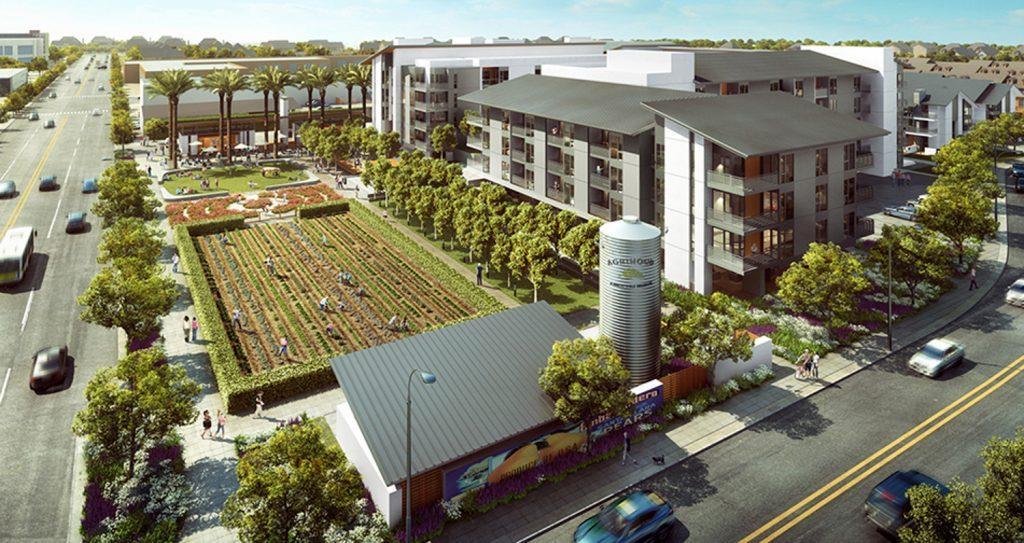

Amenities
Aerial view
113 SMART VILLAGE 17011AA006
Site plan

Floor plan of an apartment

114 SMART VILLAGE 17011AA006
The proposal is a five-minute bus ride from the area’s most high-profile tourist attraction, the Winchester Mystery House.
The affordable housing construction is expected to cost $85 million, with over $60 million in subsidies. Given that the parcel is already vacant, construction is expected to take two to three years from groundbreaking

Farming in community

115 SMART VILLAGE 17011AA006
Proposed renders



116 SMART VILLAGE 17011AA006
05. SITEANALYSIS
117 SMART VILLAGE 17011AA006
5. Site analysis – Smart Village
5.1 Location
The proposed site is located in Bhuvanagiri town, Yadadri-Bhuvanagiri district, Telangana, India.
Location of Telangana state in India

Location of Yadadri-Bhuvanagiri district in Telangana
Location of Bhuvanagiri town in Yadadri-Bhuvanagiri
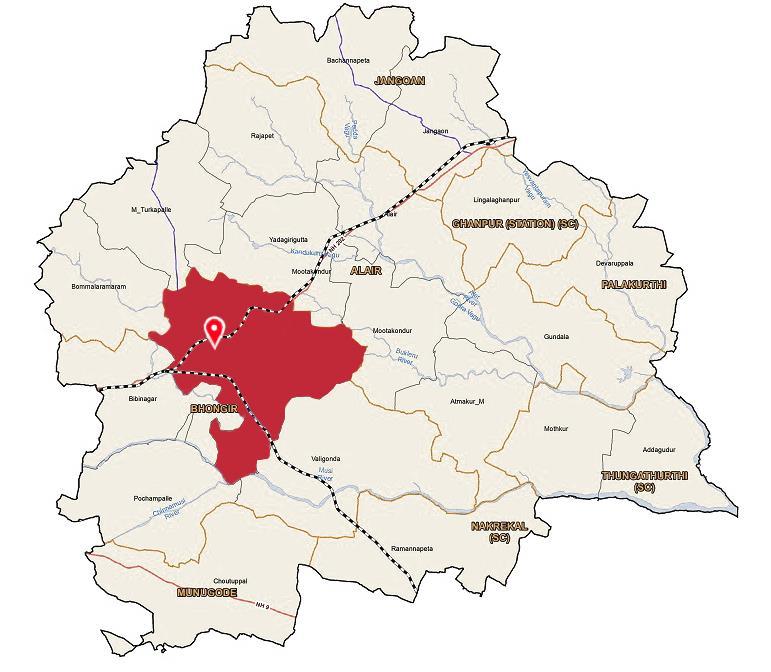

118 SMART VILLAGE 17011AA006
5.2About Bhuvanagiri
• Bhuvanagiri (Bhongir) is a town and headquarters of Yadadri Bhuvanagiri district of the Indian state of Telangana.
• Falling under Hyderabad Metropolitan Development Authority, the town is located on National Highway 163 & National Highway 161AA (India), about 47 km from state capital Hyderabad Central Point.
• The main occupation of this town is agriculture and the topography of the town is mostly covered with flatlands, croplands, waterbodies and hillocks
• Yadadri Bhuvanagiri district is considered to be the most happening place in Telangana.

• Yadadri temple, previously known as Yadigirigutta is one of the most prestigious pilgrim development of Telangana and is fast transforming into a most sought after pilgrimage center in Telangana.
• The tourism development and the district headquarters are catalyzing the immense growth in the real estate field here.
5.3 Demographics
• As of 2011 India census, Bhuvanagiri town had a population of 53,339.
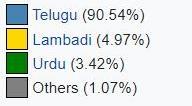
• Males constitute 51% of the population and females 49%.
• Bhuvanagiri has an average literacy rate of 70%, less than the national average of 74.04%.

Languages spoken in Bhuvanagiri town
119 SMART VILLAGE 17011AA006
5.4
Land use zone classifications
(Annexure to G.O.Ms.No.33)
The Land Use Zoning Regulations contain the following classification of the broad land use zones:
RESIDENTIAL USE ZONE
• Residential Zone-1 (Urban Areas Contiguous to Growth Corridor): Residential Zone falling within such contiguous urban area, i.e. the area contiguous outside Growth Corridor, wherein the detailed planning of roads and various urban use zones are proposed.
• Residential Zone-2 (Urban Nodes): Residential Zone falling within non contiguous urban areas, for which the detailed planning of roads and various urban use zones are proposed.
• Residential Zone-3 (Urban Centers): The remaining other urban centers along with their surrounding areas as earmarked in the proposed Land Use Plan. There is no detailed planning proposed herein presently, and the whole identified centers/areas are assigned Residential Land Use Zone.
• Residential Zone-4: All the rural settlements- Village Settlement (Gramkantham) and the existing rural built-up area- as earmarked in the proposed Land Use Plan are assigned Residential Zone-4. For all these settlements, an additional 300 M wide belt outside the gramkhantam boundary shall also be considered as Residential Zone-4 to cater the natural expansion of settlements, except in Bio Conservation Zone
OTHER ZONES
• Peri-urban use zone : Areas earmarked as Peri-Urban Use Zone, around the identified ‘Urban Areas Contiguous to Growth Corridor’and ‘Urban Nodes’ in the proposed Metropolitan Development Plan.
• Commercial use zone: Areas earmarked as Commercial Use Zone and the commercial Strips in the proposed Land Use Plan.
• Recreation and open space use zone: Recreational Use Zone: Areas earmarked as Open Space Recreational in the proposed Land Use Plan, and the sites specifically earmarked as Parks, Playgrounds, and Exhibition Grounds
120 SMART VILLAGE 17011AA006
5.5 Proposed land use zoning of Bhuvanagiri -2031
The proposed site is located under Residential Zone-2. All types of residential buildings, schools, and health facilities are permitted in residential zone-2.
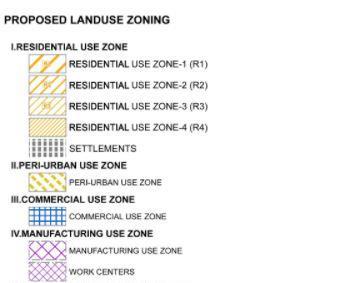
oMetropolitan Development Plan-2031 For Hyderabad Metropolitan Region

PROPOSED LAND USE ZONING OF BHUVANAGIRI2031
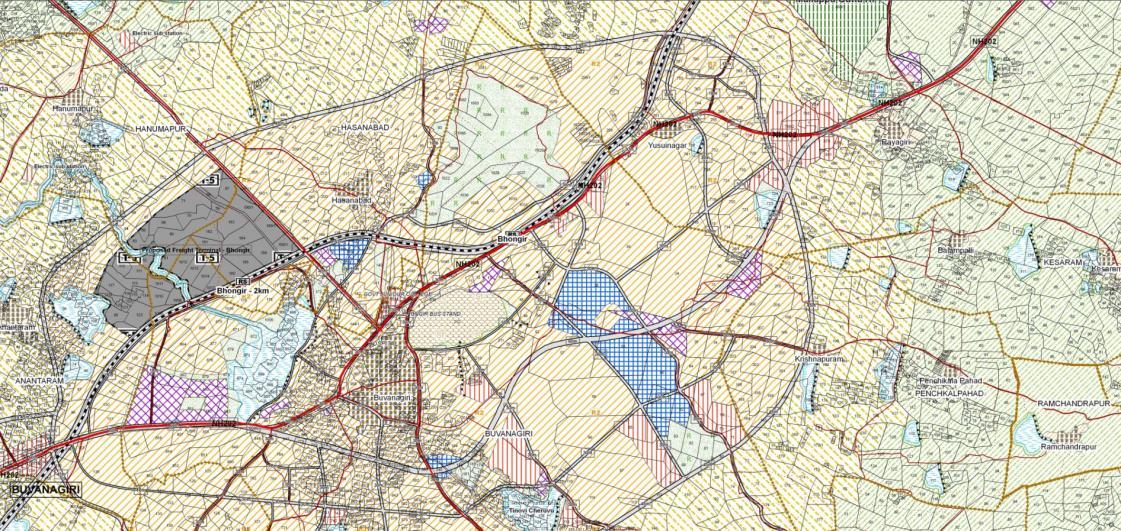


121 SMART VILLAGE 17011AA006
5.6 Site details
Site area : 207650 sq.m or 51 acres

Site address : SLNS Hills, Bhuvanagiri, Telangana, India - 508116
Site coordinates : 17.5078° N, 78.8802° E
Site zone : Residential zone
Proposed site
5.7About the site
• The proposedsite is located in heart of Bhuvanagiri town.
• The site is a HMDAapproved layout.
• Loaded with amenities and strategically located, the site is perfect for the ones who desire to live on the outskirts of Hyderabad city with many schools, colleges, hospitals, supermarkets, recreational areas, parks and many other facilities nearby Bhuvanagiri.
• This residential layout relishes a magnificent view and presents a perfect example of eco-living.
• The site is accessed by National Highway 163 via Hyderabad-Bhongir route.
5.8 Site surrounding context
North – residential settlements and flat lands
West – crop lands and residential settlements
East - hillocks
South – flat lands
122 SMART VILLAGE 17011AA006
N
5.9 Climatic data
In Bhongir, the wet season is oppressive and overcast, the dry season is mostly clear, and it is hot year round. Over the course of the year, the temperature typically varies from 16°C to 39°C and is rarely below 13°C or above 42°C
Average Temperature in Bhongir
• The hot season lasts for 2 1 months, from April 1 to June 4, with an average daily high temperature above 37°C. The hottest month of the year in Bhongīr is May, with an average high of 39°C and low of 28°C
• The cool season lasts for 3.3 months, from October 22 to January 31, with an average daily high temperature below 30°C The coldest month of the year in Bhongīr is December, with an average low of 16°C and high of 28°C.
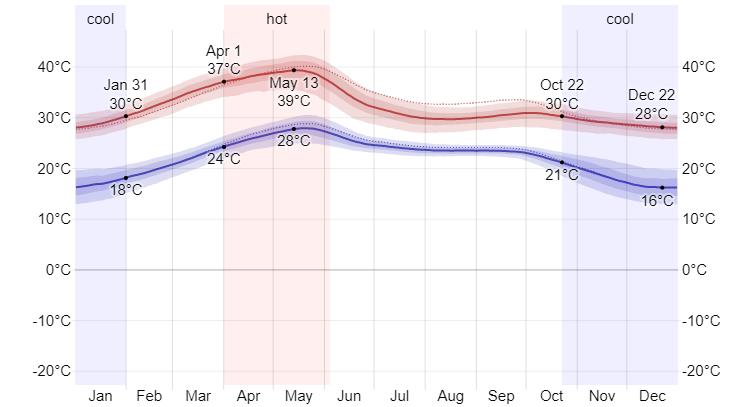
Average High and Low Temperature in Bhongīr
Sun
• The length of the day in Bhongīr varies over the course of the year In 2021, the shortest day is December 21, with 11 hours, 5 minutes of daylight; the longest day is June 21, with 13 hours, 11 minutes of daylight
Hours of Daylight and Twilight in Bhongīr

123 SMART VILLAGE 17011AA006
Clouds
• In Bhongīr, the average percentage of the sky covered by clouds experiences extreme seasonal variation over the course of the year.
• The clearer part of the year in Bhongīr begins around October 13 and lasts for 7.0 months, ending around May 13.
• The cloudier part of the year begins around May 13 and lasts for 5.0 months, ending around October 13

Cover Categories in Bhongīr
Rainfall
• Bhongīr experiences extreme seasonal variation in monthly rainfall
• The rainy period of the year lasts for 8.3 months, from March 12 to November 23, with a sliding 31-day rainfall of at least 13 millimeters. The month with the most rain in Bhongīr is August, with an average rainfall of 155 millimeters.
• The rainless period of the year lasts for 3 7 months, from November 23 to March 12. The month with the least rain in Bhongīr is December, with an average rainfall of 3 millimeters
Monthly Rainfall in Bhongīr

124 SMART VILLAGE 17011AA006
Average
Cloud
Wind
• The windier part of the year lasts for 3 1 months, from May 24 to August 28, with average wind speeds of more than 15.4 kilometers per hour. The windiest month of the year in Bhongīr is July, with an average hourly wind speed of 20.1 kilometers per hour.
• The calmer time of year lasts for 8.9 months, from August 28 to May 24. The calmest month of the year in Bhongīr is December, with an average hourly wind speed of 10.0 kilometers per hour.
Wind Speed in Bhongīr
Wind direction
• The wind is most often from the south for 3.9 months, from January 19 to May 15, with a peak percentage of 60% on April 15 The wind is most often from the west for 4.4 months, from May 15 to September 28, with a peak percentage of 93% on July 30 The wind is most often from the east for 3.0 months, from October 20 to January 19, with a peak percentage of 51% on January 1


125 SMART VILLAGE 17011AA006
Average
Wind Direction in Bhongīr
Humidity
• The muggier period of the year lasts for 7.4 months, from April 2 to November 15, during which time the comfort level is muggy, oppressive, or miserable at least 31% of the time. The month with the most muggy days in Bhongīr is August, with 30.3 days. The month with the fewest muggy days in Bhongīr is January, with 3.3 days. Wind rose diagram of Bhongir

Humidity Comfort Levels in Bhongīr

126 SMART VILLAGE 17011AA006
5.10 Topography
• The geographical co-ordinates of the site are 17 5078° N latitude and 78.8802° E longitude.
• The site has an average elevation of 450 metres
• The site is almost levelled with gentle slope towards west.
• The site is surrounded with a few settlements and mostly covered with hillocks, flat lands and crop lands
• Bhuvanagiri town falls under “Zone-II” Seismic zone which is the least seismic active region As it is an inactive zone for earthquakes, the zone is considered to be safe for construction.
5.11 Connectivity
• The site is selected on the outskirts of the city to avoid the city’s pollution but also act as a bridge between urban and rural areas by supplying resources Hyderabad is 47kms far from the site and ORR is 24kms far from the site.
• The town is well connected by road and Railways There is a bus station in 1km radius of the site and railways station in 2.5 km radius of the site.

• Telangana government is planning to develop Yadadri into a major religious tourist destination. In few months from now, it would become the most sought after tourist and pilgrimage centre
• Bhongir fort, which stands on a monolithic rock, is considered a popular tourist destination and coupled with a thrilling climbing experience. There is also a rock climbing school in Bhongir fort.
5.12 Proximities
127 SMART VILLAGE 17011AA006
5.13 Site plan

5.14 Site measurements
• All units are in meters.
Site area = 207650 sq. m.

128 SMART VILLAGE 17011AA006
5.15Aerial view of the proposed site


129 SMART VILLAGE 17011AA006
SITE
6. BIBLIOGRAPHY
1. http://www.mpurban.gov.in/Uploaded%20Document/guidelines/15%20UR DPFIGuidelinesVol_IDraft_1.pdf
2. https://www.youtube.com/watch?v=ETkiiap4qEU 3. https://www.youtube.com/watch?v=gdvJFzGUs8Q 4. http://unnat.iitd.ac.in/app/webroot/files/generaldocuments/Guidelines%20and%20Case%20Studies%20for%20Integrated% 20Village%20Development%20Planning.pdf 5. https://www.archdaily.com/963984/valentino-gareri-atelier-proposes-a-newmodel-of-sustainable-and-3d-printed-residential-village 6. https://www.slideshare.net/gauravhtandon1/smart-villages 7. https://www.irjet.net/archives/V4/i12/IRJET-V4I12171.pdf
8. https://www.irjet.net/archives/V4/i12/IRJET-V4I12171.pdf 9. https://www.slideshare.net/ShantanuHinge/village-case-study
10. https://www.thebetterindia.com/46217/india-smart-village-assambarsimaluguri-indo-bhutan-border/
11. https://mohua.gov.in/upload/uploadfiles/files/URDPFI%20Guidelines%20V ol%20I(2).pdf 12. https://www.slideshare.net/NITYAMDOSAR/urdpfi-2016 13. https://bmtpc.org/DataFiles/CMS/file/Design_Concept_Central_IAY_final. pdf 14. https://www.ecoideaz.com/innovative-green-ideas/inspiring-self-poweredvillage-odanthurai 15. https://www.worldwidejournals.com/international-journal-of-scientificresearch(IJSR)/recent_issues_pdf/2014/September/September_2014_1493017932__ 186.pdf 16. https://enrd.ec.europa.eu/enrd-thematic-work/smart-and-competitive-ruralareas/smart-villages_en 17. https://aravitesh.wordpress.com/2018/05/16/ar-aviteshs-blog-4/ 18. http://data.conferenceworld.in/PGMCOE/P929-938.pdf 19. https://gtl.csa.iisc.ac.in/nv/Mypublications/C/z.pdf 20. https://www.academia.edu/34353465/AFFORDABLE_HOUSING_IN_BA NGALORE_An_Approach_for_private_builders_to_the_affordable_housin g_sector 21. https://www.academia.edu/34353464/DISSERTATION_ON_AFFORDABL E_URBAN_HOUSING_IN_INDIA_An_Approach_to_Public_Private_Part nership_to_the_affordable_housing_sector 22. https://issuu.com/silpavallabhaneni/docs/pdf_report_final_rotated_compres sed__1_ 23. https://issuu.com/silpavallabhaneni/docs/pdf_report_final_rotated_compres sed__1_ 24. https://issuu.com/yogitagairola/docs/group_housing_lib_study.pptx
130 SMART VILLAGE 17011AA006




















































































































































